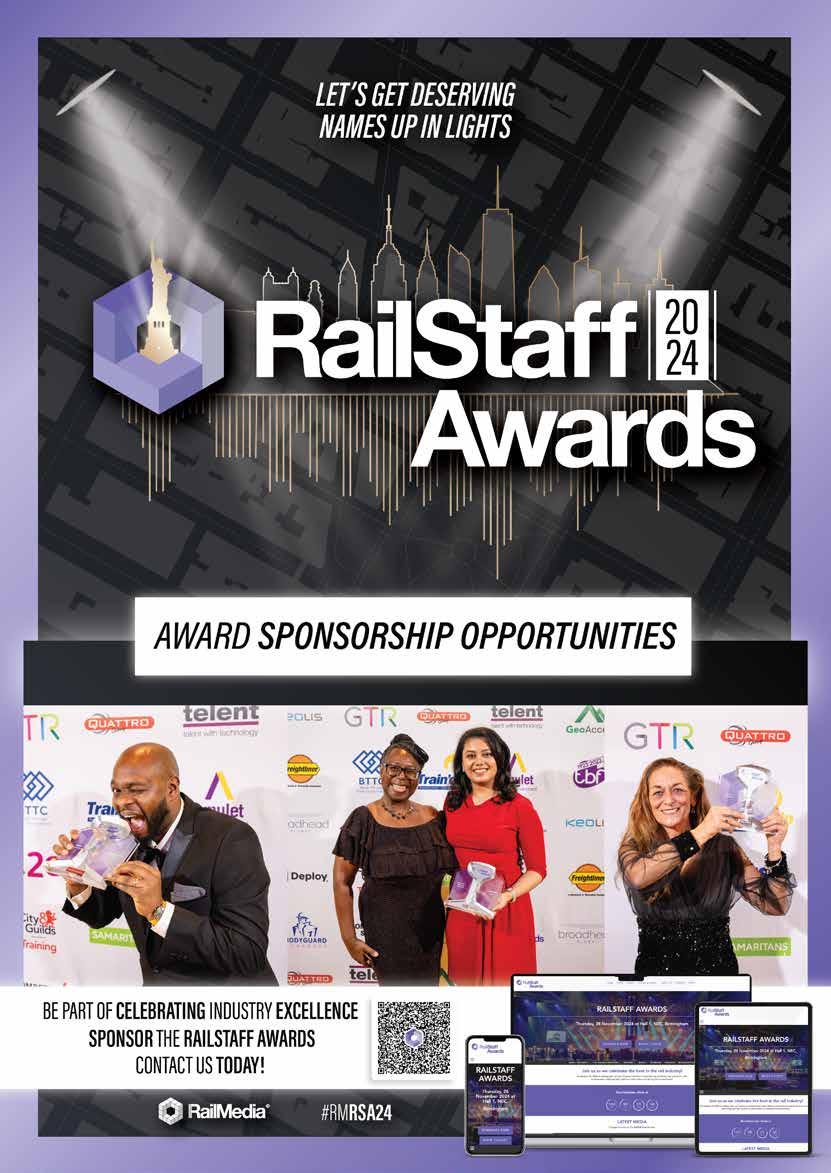










Class leading Natural Rubber wiper blade range (RWB) now available in sizes up to 1200mm


Robust 316 Stainless Steel Construction
Rail Safety Claws Prevent Screen Damage
Optimised Natural Rubber Profile For Rail
The class leading RWB range of glass safe stainless steel wiper blades has now been extended following investment in equipment and tooling technology. This advantage now enables us to extend the range previously capped at 1000mm up to 1200mm in length.
Our popular RWB heavy-duty blade has all the benefits of robust construction and corrosion resistance that you would expect from its 316 stainless steel build, combined with our unique polymer safety claws and moulded natural rubber wiping profile.
Although rare, rail wiper blades can be compromised in service by bird stikes and debris.
The RWB blades are not only stronger to resist damage whilst providing maximum water clearing performance, they remove the risk of damage to windscreens from metal claws and the huge cost and downtime of having to subsequently change screens.




Wabtec Faiveley Project Engineer









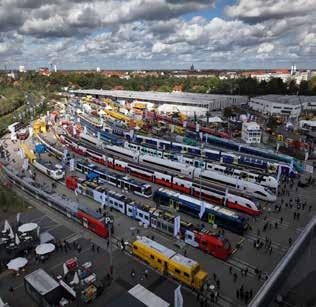
| 14
The online event aims to make individuals and organisations fitter, more resilient, and able to tackle any challenge.
| 18
Daisy Chapman-Chamberlain explores the link between access to travel and community wellbeing.
MATTHEW MOXON, NORTHERN | 24
Matthew Moxon, head of talent acquisition at Northern, discusses the unique challenges of recruiting into the industry.
STAFF RETENTION AND DEVELOPMENT WITH SELF-DELIVERY | 38
Carlisle Support Services is cutting down on sub-contractors and bolstering its commitment to recruitment and training. HONOURING THE INDUSTRY'S CONTRIBUTION AND SACRIFICE | 40 Railway Mission reminds us of the efforts of the rail industry during the first and second world wars.
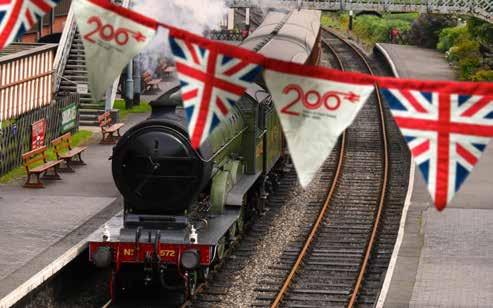






























































































Contact us:
Editor: Matt Atkins
Production and design: Adam O’Connor
Copy editor: Michelle O’Connor
Track safety: Colin Wheeler
Advertising: Asif Ahmed Craig Smith
Contact email addresses
News: news@rail-media.com
Track safety: colin@rail-media.com
Pictures: pictures@rail-media.com
Adverts: adverts@rail-media.com
Subscriptions: manda@rail-media.com
Contact details
RailStaff Publications, Rail Media House, Samson Road, Coalville, Leicestershire, LE67 3FP.
Tel: 01530 816 444
Fax: 01530 810 344
Web: www.railstaff.co.uk
Email: hello@rail-media.com Printed
RailStaff


With the summer now behind us, the nights are quickly closing in and the creature comforts of home are becoming more appealing in the face of the cold outdoors. Autumn is a busy time for rail, as final preparations to protect the network from the elements are completed and we prepare for whatever winter will throw at us.

Though it’s a perennial concern, health and safety is on our minds a little more than usual at this time of year and our focus this issue is on how staff can keep themselves safe and in tip-top condition. We kick off with a look ahead to Rail Wellbeing Live, the online event backed by organisations across the entire industry, and hear how both employees and employers can share the responsibility in managing stress and maintaining mental wellbeing.
Our regular columnists provide sage advice, with Daisy Chapman-Chamberlain exploring how the railway provides a means of improving mental health by opening up the world beyond our doorstep. Colin Wheeler’s regular column goes on to explore the common themes that run through the most recent set of RAIB safety reports.
Recruitment and training is another pressing issue. After a year in the role, Matthew Moxon, head of talent acquisition at Northern, discusses the specific challenges facing industry recruiters, how rail can be overlooked as a career pathway, and how, as a newcomer himself, his eyes have been opened to the possibilities on offer. Carlisle Support Services also tells
us how it’s moving away from the use of sub-contractors for non-specialist roles and investing in its own staff. This, it says, is an ethical decision, which will improve industry standards. Carlisle hopes its initiative will one day become the norm.
Toward the end of the issue, Bonnie Price of Young Rail Professionals provides a report on her time at InnoTrans 2024. InnoTrans is the world’s largest trade fair for transport technology, with a large focus on rail. Spanning countless exhibition halls and outdoor exhibits, it showcases the latest rail developments and offers a glimpse into the future of rail.
InnoTrans puts the spotlight on the ongoing achievements of the industry and reminds us that there is much to be proud about. It shows how far the industry has come since its inception. On that note, January 2025 will see the start of yearlong celebrations to mark 200 years of the modern railway and Railway 200 is planning a deluge of events, exploring its past, present, and future, to mark the historic milestone.
As if that wasn’t enough to get excited about, the RailStaff Awards is nearly upon us!
The RailStaff Awards is the highlight of the industry calendar and serves as big a ‘thank you’ for each and every rail employee who strives to make the industry better. To mark the countdown, we give you a taste of what to expect and celebrate the stories of some of our past winners.
Don’t miss out - book your tickets today.
Transport for London (TfL) hosted a football festival on Saturday 14 September alongside Regent’s Park Youth League and Middlesex FA Pan-Disability League. The event marked the launch of the London Overground between Euston and Watford Junction, which will become the Lioness line this autumn.
Aspiring young footballers were met by surprise guest former Lioness Ellen Maggs, who spoke with the young players and awarded trophies to the winning teams.

Young players from Middlesex FA Pan-Disability League took part in a special match which was refereed by TfL’s Surekha Griffiths, who was recently crowned FA Grassroots Official of the Year. Surekha won the award for her role in refereeing disability football games, as well as other youth football games.
Trish Ashton, director of Rail & Sponsored Services for TfL, said: "It was really moving to see so many young people come together for this special footballing event to mark the London Overground Lioness line, and especially for them to be surprised by a former Lioness.
"The London Overground Lioness line celebrates the achievements of the England women's national football team, and we hope that when people travel on the line and see girls playing football in their local parks like we’ve seen today that it helps to encourage girls of all age groups to become more involved in sport."
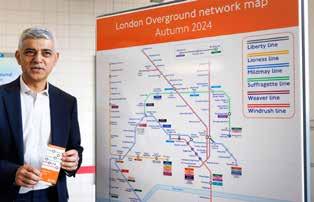
Transport Secretary Louise Haigh has fired the starting gun on rail reform by launching Shadow Great British Railways (Shadow GBR).
Shadow GBR will pave the way for Great British Railways – a new unified arm’s length body responsible for bringing track and train back together and overseeing both services and infrastructure.
The announcement comes as the Government’s Passenger Railway Services (Public Ownership) Bill continues its passage through the Commons, marking further progress in the Transport Secretary’s mission to put rail services back into the hands of the public.
The legislation reinforces the Government’s relentless focus on reversing decades of delays, cancellations and unreliable services on Britain’s railways. It aims to prioritise passengers over private companies, while saving taxpayers up to an estimated £150 million every year in fees alone.

As part of the plans for reform, the Government has recognised the need to speed up training for drivers and is collaborating with the sector to build resilience and improve productivity. Following a consultation this summer on lowering the minimum age for drivers from 20 to 18, the Government is reviewing the feedback and will lay out next steps in due course.
Transport Secretary Haigh said: “Today, I am firing the starting gun on the biggest reforms to our railways in a generation. I am determined to end the chaos, delay and disruption faced by people on train journeys every day.
“Establishing Shadow Great British Railways marks a significant step towards delivering a unified railway with passengers at its heart by bringing together track and train, and by progressing the Passenger Railways Services Bill we’re one step closer to public ownership which will help put our railways back on track.
“This Government will direct every penny into creating a stronger, more reliable rail network that works for everyone.
“This is about making the railways work for the people that use them – putting passengers first and driving up performance.”
Further measures set out by the Secretary of State include the announcement of a new Rail Sale early next year, to tie in with celebrations to mark the 200th anniversary of Britain’s passenger railways. Returning by popular demand, the sale will aim to encourage more people on to the railways by offering up to 50 per cent off train tickets for a specific time period.
On top of this, tap-in tap-out technology will be rolled out at a further 45 stations next year thanks to nearly £27 million of Government funding, meaning simpler and more flexible train travel.
Commenting on the launch of Shadow GBR, Transport Focus Chief Executive Alex Robertson, said: “Passengers want and deserve a punctual and reliable railway that delivers on the timetable’s promise at an acceptable price.
“It is good to see passenger interests featuring so prominently in the reform. We’ll continue to work closely with Government and Shadow GBR to ensure the voice of transport users is at the heart of how the changes are implemented.”

HS2 has revealed a series of improvements to the design of the railway’s landmark Birmingham Curzon Street station.
Under the detailed plans, the station will be fitted with additional cycle parking, better accessibility, more seating spaces and simplified access between platforms. There will also be changes to the construction materials to boost efficiency and minimise maintenance.
Birmingham Curzon Street Station is set to become a key destination and thriving entry and departure point as part of Britain’s new high-speed railway. The building’s design is inspired by the great arched roofs built by the Victorian railway pioneers, and takes that inspiration into the 21st Century, ensuring accessibility and a focus on the open space and landscaping around it.
Passenger experience has been a key driver in the detailed design process, which incorporates a number of improvements to the station’s features. These include additional cycle parking; rainfall capture in planted areas, with landscaping, lighting, paving and seating spaces; better accessibility at pedestrian entrances; durable external ceramic tiling; and a more unified internal layout of the eastern concourse which allows passengers to
change platforms without leaving the ticketed area, enhancing the experience of people using the station.
Further development of the materials being used will also improve construction efficiency, future-proof the station, and minimise maintenance requirements over its 120-year life span.
Major earthworks have already started on the construction site, preparing for foundation work to get underway this Autumn and building work on the main station structure to start next year.
Dave Lock, HS2’s project client director for Curzon Street Station said: “We’re pleased that these design refinements mark a key step in enhancing the detailed features of Curzon Street Station, which will be an iconic gateway to Birmingham for future HS2 passengers.
“Once built, the station will strengthen Birmingham’s transport connections, support the regeneration of Eastside and Digbeth, and play a vital role in the long-term economic future of the West Midlands.”
Improvements to the station’s arrival areas include a redesign of the southern entrance of the Eastern Concourse to make it more prominent, strengthening the arrival experience and providing better links with Digbeth.
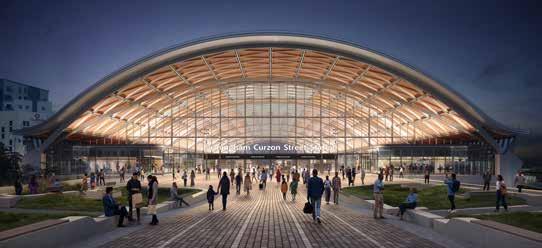
South Western Railway (SWR) is committed to closing the gender gap in the rail industry with a new recruitment campaign aimed at increasing the number of women train drivers.
Only 8% of SWR’s train drivers are women, in line with the national average. SWR is committed to increasing representation and will shortly be opening applications for vacancies in Farnham, Fratton, Waterloo, and Weymouth.
To support the recruitment drive and to encourage women to consider a fulfilling career on the railway, SWR has released a new video, featuring three women drivers - Gemma, Yasel and Sally, who share their experiences, career journeys, and personal and professional benefits of the role.
No previous rail experience is necessary – SWR’s comprehensive training programme equips trainees with the skills, knowledge, and practical experience to help them on their training journey. Once accepted for training at SWR’s Basingstoke campus, candidates must complete various training milestones including a minimum of 225 hours of driving with a driving instructor. In total, trainees will go through 18 months of training before qualifying as drivers.

The managing directors for Avanti West Coast and West Coast Partnership Development (WCPD) have outlined their future vision for customers at this year’s Stakeholder Conference.
Speaking to over 200 delegates at the event in Liverpool, the objectives for the coming months and years were outlined by both businesses.
Andy Mellors, Avanti West Coast’s managing director, highlighted the progress the operator has made in recent months to improve performance across its network. He emphasised that there is still more work to be done, particularly in collaboration with Network Rail to improve train service reliability on the West Coast Main Line.
The managing director of WCPD, Shamit Gaiger, updated the conference on the priorities and progress being made by her team on the high-speed services and the wider West Coast. She explained that the business is looking to capitalise on all the possible opportunities to ensure that the High Speed Two project delivers customer and economic benefits across the West Midlands, the North West and Scotland.
Shamit also highlighted how the WCPD work is supporting the Government’s five missions for national renewal.
Speaking after the conference Andy said: “It is vital that we all work together, as an industry and with our stakeholders, to ensure that we are continuing to improve on delivering the train service that our regions and communities deserve.”
Shamit added: “I really enjoyed engaging with our stakeholders and sharing our views on how we put the customer first and adapt innovative thinking into our designs for new high-speed services.
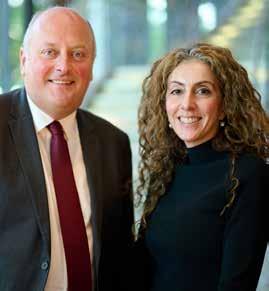
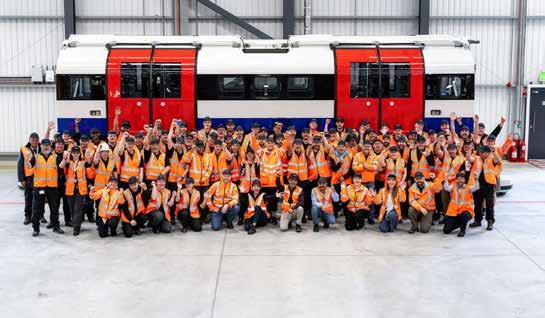
The Secretary of State for Transport Louise Haigh and the Mayor of London attended the grand opening of the Goole Train Manufacturing Facility on 3 October, marking a significant milestone for Siemens Mobility and the future of rail transportation in the region. Alongside the opening, Siemens Mobility announced a substantial investment of up to £40 million in a state-of-the-art Bogie Assembly and Service Centre, solidifying its commitment to the region.
The new Bogie Assembly and Service Centre will incorporate and expand Siemens Mobility’s current capabilities to overhaul bogies from UK trains, including the 3,224 strong fleet of vehicles (572 trains) it maintains in the UK, and will also include new production lines for assembling bogies for new trains, a first for Siemens in the UK.
This new investment will secure around 100 existing jobs and create up to a further 200. It is due to be operational towards the end of 2026.
The investment in the new service centre in Goole, Yorkshire, comes in addition to the previously announced £200 million investment in the Goole Rail Village including the Train Manufacturing Facility. This state-of-the-art facility will play a pivotal role in producing the next generation of trains for the UK, including the highly anticipated new Piccadilly line trains for Transport for London (TfL) that will transform rail travel across the capital. In addition to this, all of Siemens’ future UK train orders including Siemens Mobility’s new battery trains will be built at Goole, which is also gearing up to serving other global markets by 2030.
Commenting on the investment, Transport Secretary Louise Haigh said: “This impressive, world-class facility will be transformational to Goole and its people, providing a boost to the region’s economy and supporting hundreds of skilled jobs.
“Its opening demonstrates the importance of high quality, long-term investment to pave the way for employment and growth.
“I know how vital rail manufacturing is to our economy, which is why we will not sit on our hands when it comes to supporting it. For too long, the cycle of boom-and-bust has held back this sector.
“That’s why I am determined to put an end to the stop-start approach to investment and provide the industry with the certainty it needs to deliver a railway that is fit for the future."
Sambit Banerjee, Joint CEO at Siemens Mobility, expressed his excitement about the opening and the investment's potential to nurture the next generation of trains in Britain. He said:
"After more than a decade of tremendous dedication and hard work, we have officially opened our state-of-the-art Rail Village in Goole which is testament to our commitment to the North of England. None of this would have been possible without the brilliance, perseverance, and passion of our people and I’m incredibly proud of what we have achieved together. We’ll assemble 80% of London's new Piccadilly line trains and all future Siemens trains for the UK including our Verve battery train here in Goole and I’m pleased that we are supporting the local supply chain in the process. Our further investment in the Bogie Assembly and Service Centre will only add to our ability to transform rail and transport for everyone, right here in Goole.”
The establishment of the service centre marks another significant milestone in Siemens Mobility's dedication to building in Britain and reinforces its belief in Yorkshire's potential as a central hub for train manufacturing.
The Goole Rail Village consists of the Train Manufacturing Facility which assembles and commissions trains, the Components Facility where Siemens maintain gearboxes, traction motors and other parts for train and tram fleets, the Logistics Centre warehousing facility and the Rail Accelerator and Innovation Solutions hub for Enterprise (RaisE) business centre, all of which will now be joined by the Bogie Assembly and Service Centre.
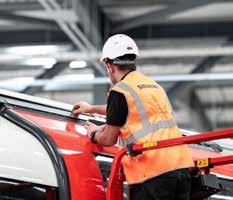
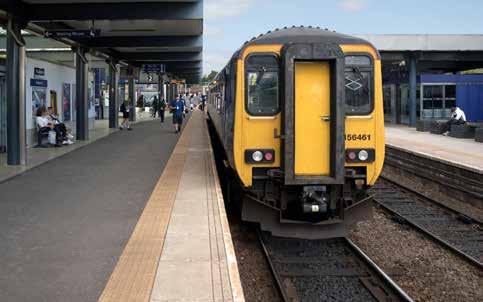
who travel on our services and are trained to respond to a wide range of challenging situations.”
James works for Northern and Abdi is employed by Carlisle Support Services (CSS), a company which provides gateline staff for the train operator.
Two members of staff have been praised for finding a missing eight-year-old girl and getting her to safety.
James Waring and Abdi Sharey were working at Blackburn Station in August when they saw the unaccompanied child walking towards the ticket barriers.
After asking her some questions, they became concerned for her welfare and decided to contact the police.
Greater Manchester Police, which had launched a major search operation to locate the child earlier that day, sent officers to pick her up and reunite her with her family
Craig Harrop, regional director for Northern, said: “We’re incredibly proud of James and Abdi for reacting so quickly to help to reunite this girl with her family.
“Staff working at stations across our network are not just there to check tickets. They help protect thousands of people
The biggest overhaul of bogies belonging to Avanti's train fleet has reached a major milestone with the initial phase of the project completed.
The first part of the work to overhaul 1,148 bogies – a framework with wheels that sits underneath the train carriage – across Avanti West Coast’s Pendolino fleet has been completed by the UK’s leading train supplier, Alstom.
All 35, 11-carriage Pendolinos have had their sets of 22 bogies examined and reconditioned to give them a new lease of life after clocking up over 750,000 miles – the equivalent distance of travelling to the moon three times.
In just one year, 770 bogies have been revamped by Alstom’s
facility in Crewe – a centre of excellence for component repair and overhaul.
It is part of a wider programme of work on the Pendolinos –known as a heavy overhaul, which each week sees component parts including, pantographs, train control and information systems, batteries, and valves reconditioned or replaced. In one week, Alstom’s teams in Crewe and Manchester will replace 24,456 individual fixings and 9,511 parts, as well as repair 249 items.
The heavy overhaul, which follows the award-winning £117 million investment programme to refurbish the Alstom-built Pendolino trains, is designed to ensure the fleet continues to provide a reliable service.

Steve Cere, director of rail strategy for CSS, said: “This incident highlights the importance of having a visible staff presence across the network and underscores our commitment to actively ensuring that safeguarding is everybody’s responsibility.
“James and Abdi’s actions underscore our team’s dedication to keeping all passenger’s safety and wellbeing at the forefront of everything we do, and we couldn’t be prouder of them.”
Since 2022, Northern’s operational colleagues have been trained to spot vulnerable people on the railway and get them to safety.
The training is provided by the charity ‘Railway Children’, whose work focusses on identifying individuals at risk and helping with early forms of intervention.
Alstom has announced the introduction of a new sectorleading maternity and adoption policy for staff in the UK, reinforcing its commitment to supporting gender equality and the well-being of its workforce.
The enhanced policy offers employees on maternity and adoption leave full pay for up to 12 months. This policy is also viewed as a critical part of Alstom’s commitment to supporting female retention and attracting new talent into the organisation and wider rail sector.
Alstom is also focused on mitigating the effects of the ‘pregnancy penalty’ – a recognised phenomenon where women returning from maternity leave often struggle to regain their previous career momentum. This policy serves as a pivotal step toward eliminating this issue by supporting women in achieving their full potential upon returning to work. For example, it helps ensure that women do not face financial disadvantages from taking leave of up to a year or
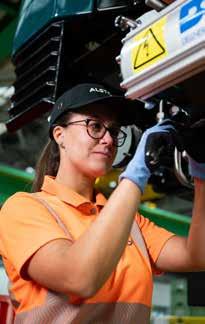
feel pressured to return to work before they are ready.
The new maternity and adoption policy is open to those who have worked at Alstom for at least two years and offers full earnings for 52 weeks’ maternity leave. It also offers enhanced payments to all employees who qualify for statutory maternity pay or adoption pay.
Chiltern Railways has unveiled the first train of a £12million fleet refurbishment as part of the operator’s mission to provide easier, greener and better journeys for customers in the future.
One of the operator’s fleets (Class 168) is being refurbished with modern features and modifications including improved Wi-Fi, USB sockets, a full repaint and an overhaul of the heating and cooling system. The first refurbished train was unveiled during a special event attended by rail partners, user groups, and Chiltern colleagues at London Marylebone station on Wednesday 9 October.
The man tasked with preparing Northern for autumn said the train operator is ready to tackle the “big problem” of fallen leaves on the line.
In his tenth autumn with Northern, seasonal performance improvement manager Rob Cummings is working hard to minimise disruption for customers and ensure they reach their destinations safely.
Northern spent nine months preparing for this autumn and completed the rollout of additional equipment on its fleet of trains in July.
Thameslink has released an audio guide that describes its vast fleet of 115 trains, written with the help of a blind passenger from Redhill in Surrey.
Dave Smith sits on Thameslink’s Accessibility Advisory Panel to help it improve services for disabled people.
He said: “I use these trains all the time but for someone else who is blind or partially sighted it can be incredibly daunting. When you can’t see, it’s difficult to understand your environment and what’s around you.
“Anyone can log onto the Thameslink website and listen to this audio guide before setting off, helping them understand the train layout before they travel, helping reduce any anxieties.”
A life-sized replica of a Tyne and Wear Metro train wowed audiences at Newcastle’s Theatre Royal from 2 to 5 October.
The mocked-up Metro prototype, carriage 4001, in its familiar 1980s colour scheme, was the centrepiece for Gerry and Sewell - a play which tells the story of two Gateshead lads who are desperate to see their team, Newcastle United, play at home.
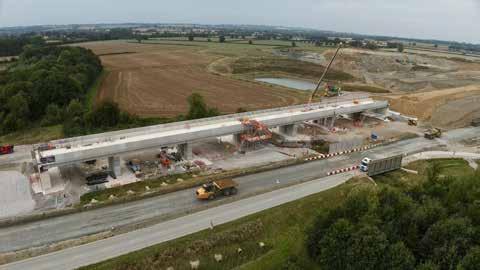
A viaduct in Northamptonshire has officially become the first on the HS2 project to be completed as engineers working for the high speed rail project installed the last stretch of parapet along the sides.
The 163-metre-long Highfurlong Brook Viaduct, near the village of Aston le Walls, is one of more than 50 being built as part of the new rail project, which is designed to improve journeys between London and the North, while freeing up space on the most crowded part of the existing West Coast Mainline for more freight and local services.
Consisting of seven spans, the viaduct crosses Highfurlong Brook’s floodplain at a height of around nine metres. Each span is made up of four beams weighing up to 56 tonnes and were lifted into position last year to form the backbone of the structure.
Each of the beams – which are up to 25 metres long - were manufactured off site before being delivered over night to reduce disruption for local road users. The deck –which will support the track and electrical systems – was poured in situ earlier this year, with the parapets along each side manufactured off site and installed over the last four months.
The viaduct is one of around 500 bridging structures on the HS2 project which range from small road bridges and drainage culverts to massive viaducts like the record-breaking Colne Valley Viaduct which will become the longest in the UK when its deck is completed.
Bill Price, HS2 Ltd’s project client said: “The completion of our first viaduct is a major moment for the HS2 project and I’d like to thank everyone in our integrated project team and supply chain partners who have worked so hard to get us where we are today.
“It’s great to see Highfurlong Brook finished and I look forward to seeing many more of our viaducts, bridges, stations and tunnels come together over the next few years.”
Highfurlong Brook was delivered over two years by HS2’s main works contractor EKFB – a group made up of Eiffage, Kier, Ferrovial Construction, and Bam Nuttall. The design was done by EKFB’s design partner ASC working with architect Moxon.
With the viaduct now structurally complete, the next phase of construction will include delivering the earthworks that support the railway at either end before a separate set of contractors comes in to install the rail systems, including track, signalling, power and communications systems.
Scott Corsar, EKFB’s project manager said: “We have achieved many ‘firsts’ with Highfurlong Viaduct, from the first viaduct to have its full deck installed to the first structurally complete viaduct on the HS2 programme following the recent installation of 136 parapets.
“This would not have been possible without the hard work, consistency and collaboration of everyone involved with the structure, from our designers down to our operatives out on site.”
A Freightliner locomotive has been named after Pete Waterman OBE in recognition of his contribution to the Railway industry.
The loco naming, which took place at Crewe Railway Station on 11 September, was arranged as a collaborative celebration by the Railway Benefit Fund Charity, Avanti West Coast and Freightliner, where Pete was awarded the naming with a presentation from Tim Shoveller, CEO Freightliner Group.
In the last five years Pete has held the role as president of the Railway Benefit Fund, a charity which provides support to current,
former, and retired UK railway people and their families.
In his time as charity president, Pete has raised donations of almost £2 million pounds which goes towards sustaining the charity and providing much needed support to railway people and their families.

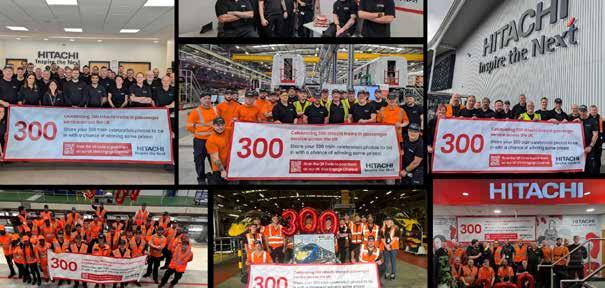
Hitachi has delivered its 300th train for UK passengers. The delivery of the latest Class 807 for Avanti West Coast represents a significant milestone in the ongoing transformation of the UK railways, which began with the introduction of the iconic Class 395 Javelin train in June 2009.
Over the past 15 years, Hitachi Rail has collaborated with partners across the rail industry, making it possible to travel from Penzance to the Scottish Highlands on Hitachi trains.
The diverse Hitachi Rail fleet includes Scotland’s fastest commuter train (Class 385) on Scotland’s Central Belt, the reliable intercity Class 800 on the East Coast Mainline, to the UK’s fastest passenger train (Class 395) on HS1, the high-speed line from St Pancras International.
Currently, Hitachi Rail trains operate across 10 fleets, which collectively achieve reliability rates three times higher than the industry average, whilst traveling far enough to journey to the moon and back over 100 times every year. This performance has been recognised with numerous industry awards for fleets including LNER Azuma, ScotRail’s Class 385, Hull Trains, and Lumo.
With 2,100 high-skilled maintenance employees across 16 sites, and leveraging an extensive UK supply chain, Hitachi’s maintenance operations contribute £500 million gross value add to UK economy every year.
Jim Brewin, chief director of UK & Ireland Hitachi Rail said:
“Delivering our 300th UK train is symbolic of what the rail industry can achieve through strategic partnership.
“Transforming levels in reliability, capacity and performance across Britain’s railways is only possible due to the quality of industry partners we have in the UK.
Going from 1 to 300 trains in just 15 years is credit to the incredible people that have embodied the spirit of Hitachi Rail. With exciting innovations in green and digital technology being developed in the UK, Hitachi Rail is already working towards the future.”
On Thursday 12 September, Network Rail collaborated with emergency services and industry partners in a live action exercise to test their readiness to respond in emergency situations.

The exercise, known as Operations Salthouse #2, simulated a train derailment, including multiple injuries – and complicated by a flask of nuclear material being transported in the opposite direction. Responding to the incident, colleagues from the police, British Transport Police, fire and ambulance services, Northern Trains, and Direct Rail Services, supported by the Radsafe team and Network Rail’s own teams worked together to secure the scene and evacuate the train’s passengers, played by local extras and representatives from Casualties Union and Furness college.
A Rail Incident Office from Network Rail coordinated the multiagency response, supported by a Tactical Incident Leader.
The exercise proceeded according to plan, allowing us to work closely with key agencies to
ensure that we are joined up in the event of an incident. It also allowed emergency responders to carry out the first ever live trial of the 'ten second triage' protocol developed in the aftermath of the Manchester Arena bombing.
Wendy Potter, Network Rail’s operations manager for Cumbria, said: "By holding detailed scenarios such as this, we help to make sure that our processes are robust, and that we are well prepared to keep our passengers and communities safe. I’d like to say a huge thanks to our partners from Northern, Direct Rail Services and the emergency services for taking part in the exercise.
"Events like this are vital for testing the way we will work together in an emergency. We will review the exercise in detail and the lessons we learn will be implemented going forwards."
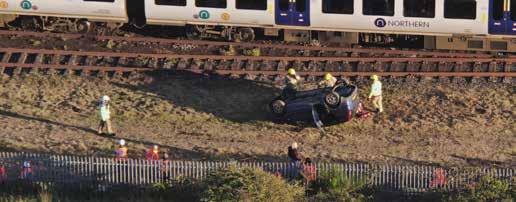
Employees working for Northern are being given special training to help protect the rising number of vulnerable people using the railway.
The train operator’s conductors, customer service and station staff interact with tens of millions of passengers a year – among which will be people subject to abuse, addiction and intimidation as well as a range of mental heath issues.
Having the confidence to act when they spot something ‘not quite right’ requires the right skills and a knowledge of the best ‘next steps’ to help the person in need.
The training forms part of Northern’s membership of the Safeguarding on Rail Scheme (SRS). It is delivered by the charity ‘Railway Children’, whose work focusses on identifying individuals at risk and helping with early forms of intervention.
Over the summer, Northern employees came to the aid of three customers with potentially life-saving interventions.
In July, a conductor made sure a passenger got swift medical treatment
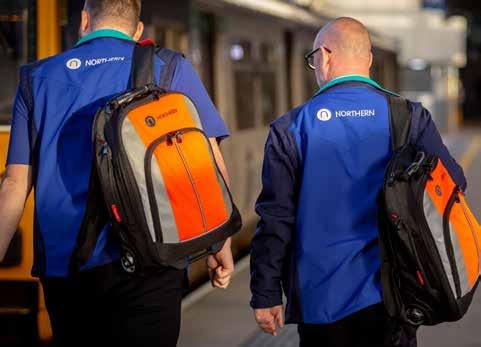
when her condition deteriorated on-board a Northern service. In August, a conductor helped a 13-year-old boy in distress while working a service heading to Manchester Piccadilly. And earlier this month, two employees at Blackburn station were praised for finding a missing eight-year-old girl.
Lisa Leighton, people director at Northern, said: “Everyone who works on the railway has an important part to play in supporting and protecting the vulnerable people who use our trains and stations.
“In the last three months alone, colleagues
across our network have intervened to help people in distress on a number of occasions – and I’m so relieved they did.
“As someone who volunteers for Samaritans, I know how important it is for people to receive the help they need, when they need it most.
“Training courses like the one we’re delivering to our employees could make all the difference to someone going through a hard time.”
The Safeguarding on Rail scheme (SRS) was developed by the Department for Transport and British Transport Police.
The first official partnership between Network Rail Severn Valley Railway (SVR) is celebrating 12 months of successes and achievements.
Network Rail’s Central route and SVR signed its unique partnership just over a year ago, providing an opportunity for each to benefit from the other’s expertise, technology and facilities.
The blossoming relationship has seen a host of benefits delivered that either save time or money or help to make on-the-job training safer by taking place on a heritage railway when trains aren’t running.
One example of partnership working which took place earlier this year saw the past meet the present with a drone inspection of SVR’s iconic Victoria bridge.
Built in 1861, it is one of a small number of cast iron bridges remaining in the West Midlands still being used by trains and with it spanning the River Severn, routine structural assessments have traditionally been an expensive and lengthy process for the heritage railway.
The partnership meant a state-of-the-art drone with a high-resolution camera could quickly and easily access the hard-to-reach parts of the structure, reducing the survey time to hours rather than days in a move which saved SVR nearly £10,000 in inspection costs – money which could then be spent in other areas.
In return, engineers have used the heritage line as a test environment to further develop longer and more challenging drone flights ahead of potential future use on the main network and refreshed and upskilled engineers on semaphore signalling which is still in use on parts of the network in the Worcester area.
To mark the anniversary, colleagues from Network Rail and SVR joined forces to restore heritage carriages and plan future projects which will
deliver even more benefits for both heritage and main line passengers.
Denise Wetton, Network Rail’s Central route director, said: “As the first of its kind anywhere in the country, it’s clear to see this partnership brings so many benefits to both the railway of the past and the present.
“I’m pleased we have been able to help such an important heritage railway which is loved by so many people. It’s an important community asset which now plays a key role in allowing us to trial new technology and train our staff in a safe railway environment. I’m excited to see the relationship develop even further over the next 12 months.”
Gus Dunster, Severn Valley Railway’s managing director, added: “'When we set out on this partnership a year ago, we knew it was going to be a positive thing, but we didn't realise quite how beneficial it would turn out to be!
“The Severn Valley Railway has seen huge benefits in terms of generously shared advice and expertise from Network Rail as well as significant donations of surplus track assets. In return, we've been proud to facilitate training and testing opportunities for them. It's a win-win situation which we look forward to continuing to develop going forward.”
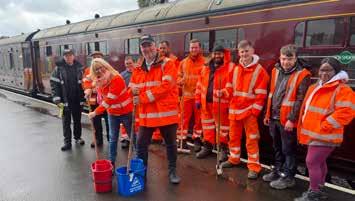
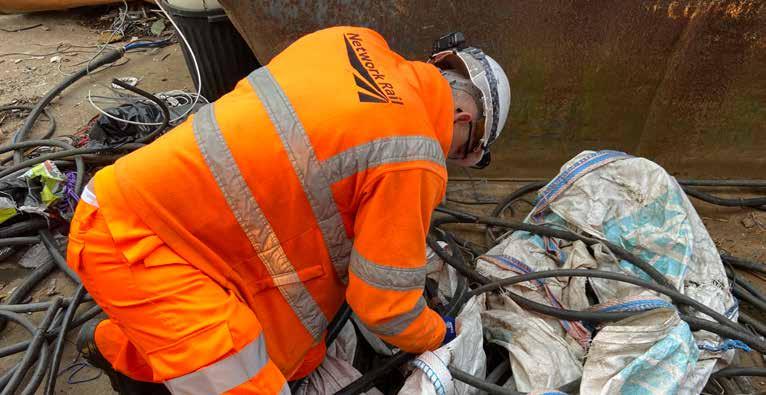
Covert crime-busting kit is being used to track down metal thieves who cause major delays to passengers and freight on the West Coast main line – Europe’s busiest mixed use railway.
Network Rail is stepping up its efforts to deter cable theft by deploying special 'trespass beads' which provide police with the ability to irrefutably link offenders to crime scenes.
Trespass beads are tiny pellets designed to break upon impact and are made up of SelectaDNA, a unique UV based DNA solution which is a proven and credible way to place a criminal at a crime scene, without their knowledge.
A special solution released by the beads can be detected by trained sniffer dogs as well as seen under special police torches, so stolen metal can be found and those who illegally sell items onward can be caught.
This is just one of many deterrents deployed including drone and covert camera use, all to dissuade thieves from this disruptive but also unsafe activity. Not only does the theft impact train services as Network Rail replaces the cable to get passengers and freight moving again, but criminals are risking their lives.
Jennifer Hartnett, Network Rail’s route crime and security manager for West Coast South, said: “Cable theft is a timely and expensive problem for the railway and it causes huge disruption to our passengers and freight services.
“To prevent it, we’re working closely with our partners at the British Transport Police and using innovative tactics like our trespass beads to help bring thieves to justice. We urge anyone who sees something suspicious on or near the railway to contact the British Transport
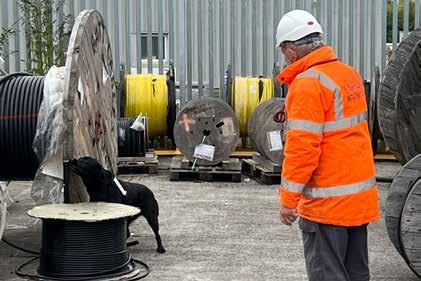
Police.”
For the financial year 2023/2024, there were 101 incidents across the national rail network, that caused trains to be delayed by 55,764 minutes at an estimated cost to the taxpayer of £4 million.
Sergeant Malik Hussain for British Transport Police, said: “We are working closely with Network

Rail to deter cable theft by using police tactics. By adopting a multi-agency approach it means we are putting ourselves in a stronger position to identify thieves and locate stolen metal.
“Our message to thieves is clear, we are aware of your activity and of the hotspots for this crime, you will be caught and brought to justice.”
01483 763 558




administration@woking-homes.co.uk

“I’ve




Rail staff face health and safety challenges unheard of in most other industries. Accidents and traumatic events, abusive customer behaviour, the toll of physical labour, and the responsibility of keeping customers safe, can all take their toll.
A safe and efficient railway relies on the individuals who turn up every day to manage it. With that in mind, Rail Wellbeing Live came into being in as the industry’s largest health and wellbeing initiative. Established by the by the Rail Wellbeing Alliance, a crossindustry group made up of dozens of companies, suppliers, and industry bodies, its mission is to make individuals and organisations fitter, more resilient, and able to tackle any challenges that come their way.
Since the initiative was launched in 2020, tens of thousands of people from across the industry have logged in to the annual online event. In 2023 alone, over 15,000 people registered, resulting in a record 56,000 sessions attended.
This year, Rail Wellbeing Live takes place from 5-7 November, and boasts high-profile speakers, including Ollie Ollerton, star of Channel 4's SAS: Who Dares Wins; Olympian Dame Kelly Holmes; ex-England footballer Stuart Pearce MBE; and author, presenter, and campaigner Katie Piper OBE.
Among other things, the programme for 2024 covers a raft of wellbeing topics including mental health, resilience, anxiety, nutrition, sleep, addiction, and money worries. Registrants can ‘pick ‘n’ mix’ the sessions they want to attend, creating their own agenda and selecting the topics that interest them most.
Expect inspiration, tips, and guidance on how to tackle some of the most pressing issues affecting rail personnel.


This year’s opening session will focus on mental wellbeing and will discuss the critical issues rail workers face in these uncertain times. Network Rail Chief Executive Andrew Haines will speak, along with a panel featuring Alex Hynes (Department for Transport); Claire Mann (Transport for London); Joana Faustino (Rail Safety and Standards Board); and Syed Asim Shah, (Network Rail). The panel will share practical tools and resources to help rail workers navigate stress and adversity.

Ruth Busby, chair of the Rail Wellbeing Live Steering Board and people and transformation director at Great Western Railway and Network Rail Wales and Western, will host the session.
“Rail Wellbeing Live is such a fantastic event and I’m proud to be a part of it,” she says. “Events like this give us all the opportunity to take stock and really invest in ourselves.
“All too often, we don’t prioritise our health and wellbeing and can suffer as a consequence. Taking part in one or more of these fantastic sessions will give you the tools to make a positive change – whether that be mentally, physically, emotionally or financially.”
Following the opening session, highlights over the next three days include:
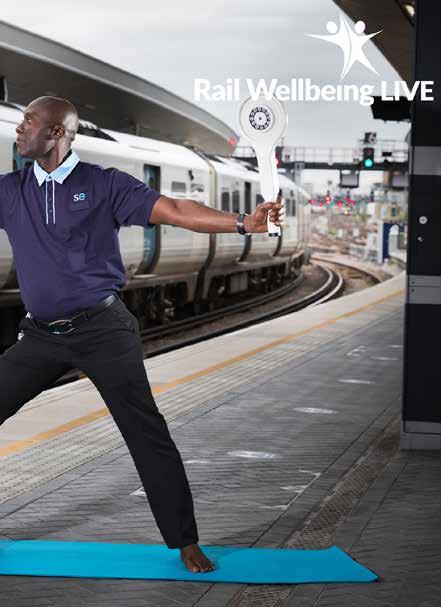
Being limitless with MasterChef’s Amar Latif OBE
Amar is a blind traveller, businessman, and TV personality with an astonishing track record of facing up to major challenges. Due to an incurable eye condition, Amar lost 95% of his sight by the age of 19. Through sheer determination, he has managed to turn an unpromising tale of loss, into one of truly inspirational achievement.
Discover the impact of ultraprocessed foods on health and wellbeing in this insightful session. Learn about the characteristics that define ultra-processed foods, their prevalence in modern diets, and their links to various health issues such as obesity, diabetes, and heart disease. This session will also explore strategies for reducing consumption and making healthier food choices.
Joshua Fletcher
Psychotherapist Joshua Fletcher will create a sense of understanding and awareness by
discussing what anxiety is, how it presents differently in people, and how to address it, particularly if it arises in the workplace. With a blend of humour and engaging psycho-education, Joshua seeks to cultivate empathy in his audience and provide hope and guidance for those struggling with anxiety. Drawing from his professional expertise and personal experience with panic disorder and OCD, he offers a unique perspective on managing anxiety.
At a time of existential global challenges, we need our best brainpower to solve them. So how do we create genius environments, help our brains flourish and boost group thinking? Neuroscientist and bestselling author of The Science of Fate, Dr Hannah Critchlow, will share how to cope with wildly differing opinions, balance our biases, prevent a corrupting force, and how we can exercise our intuitive ability to get the most effective outcomes.





Steve Watts, founder and CEO of GamFam, joins Rail Wellbeing Live to help change people's perception of gambling. He’ll be looking at what gambling is and where gambling harms start, and will explore the links between online gaming and gambling, especially now everyone has access to a 'casino in our pocket’. Steve will offer some practical advice and resources so that you feel more confident to offer support to anyone affected by gambling. Attendees will also be able to signpost people to specialised support and services.
Rail Wellbeing Live offers everyone in the industry the opportunity to come together and connect with colleagues and industry experts for inspiration, tips, and guidance on how to tackle a wide range of health and wellbeing issues.
“It doesn’t matter where you are in the rail industry, we all have similar challenges,” says Ruth.
“I’d especially like to ask line managers to encourage their team to join a RWL session. Even if you can’t join live, sessions are available afterwards so please register and watch at a time that is convenient.”
“I very much look forward to everyone coming together to improve wellbeing as one, big, railway family.”
REPORT BY MANDY GEAL & PROFESSOR PATRICIA RIDDELL
Stress is a complex problem and the responsibility for mitigating its worst impact is not always clear. Individuals are advised to reduce personal stress through activities such as meditation and taking a holiday but return to the same stressful organisational problems that they can’t fix. Front line managers are the most likely to be responsible for noticing stress in others and connecting individuals with remedies but are often so stressed themselves they don’t have the bandwidth. Organisations invest in providing resources to help employees, but people are often reluctant to use them, or they aren’t tailored for the situation or the person.
Part of the problem is that the term ‘stress’ is too general and doesn’t differentiate between the things that stress you, how you personally respond to stress, and what you need to remedy it. All these elements need to be considered to combat the potential decline in mental health and wellbeing, which results from too much stress.
Patricia Riddell, professor of Applied Neuroscience at Reading University and lecturer at Henley Business School, explains:
“A better understanding of the neuroscience of stress can help us to deal with it more appropriately. Stress is an everyday reality for almost every employee and to varying degrees we all need stress to function effectively. In engineering terms, stress is the load transmitted onto materials and strain is the measure of the resulting distortion, which can become permanent. It’s the same for people.
People have an effective mechanism for responding to and recovering from stress using a complex interplay of stress hormones, which bring them back to a resting state after a short stressful period. The diagram here shows three ‘zones’ where performance is impacted differently by stress and can help us choose when and how to act.”
In Zone 1, some stress is healthy. For example, working together with trusted colleagues to meet a short-term challenge feels rewarding and is ‘good’ stress.
In Zone 2, stress starts to become problematic, but the individual has time and remedies for recovering from the strain. For example, meeting a rushed deadline by working longer hours

istockphoto.com/CreativeDesignArt



and losing sleep, but having time off afterwards to switch off and recuperate, means the stress and the resulting strain both stop.
In Zone 3, continual stressors, for example working with insufficient time/resources to cover workload with no time to recover and no chance of improving the situation, mean stress becomes chronic. The raised level of stress hormones circulating continuously in the bloodstream turns healthy stress into toxic strain, e.g. high blood pressure and heart attack.
“Strain is detrimental to the physical and mental health of the employee and the operational and economic performance of a business and reputation as an employer,” says Professor Riddell.
But why don’t people recognise and/or admit to experiencing stress and strain?
resilience (e.g. frequent reorganisations) can inadvertently generate more stress for their employees.
Unclear responsibilities and goals; changing priorities; too much or too little communication; constant change; blame; and lack of constructive feedback create uncertainty, novelty, and lack of control, which are stressors for most people.
No ethical employer wants to be the cause of poor physical and mental health in their employees; therefore, these problems must be addressed by employers. The ethical and financial benefits are that monitoring, measuring, and pro-actively reducing strain leads to increased productivity and efficiency. (See ‘Investing in People’, RailStaff 292, Jul/Aug 2024).
Individuals find different things stressful. How much strain they experience depends upon their perceived ability to cope and their personal window of tolerance, i.e. how much stress that person can cope with, which is also affected by factors outside work. Individuals can take action to improve their response to stressful conditions and the remedies they use to recover. They can engage with organisational changes to mitigate stressful conditions.

So, what can be done?
“People suffer in silence because they fear that by voicing their concerns, they will harm their current and future job prospects or be perceived as weak or ineffective,” Professor Riddell says.
“It’s difficult for people to recognise they are in Zone 3 (chronic stress) so they may be unaware they need support. Stress affects the quality of work and the resulting performance of people, leading to more strain.”
For the most effective solutions, responsibility for tackling stress and strain needs to be shared.
Organisations have a huge impact on sources of stress for their employees through their working environment and culture. For example, some actions taken by employers to build organisational
“The first step is to quantify the scale of the problem and to isolate what is causing strain in an organisation,” says Professor Riddell. “One challenge facing employers, however, is that what Employee A may regard as toxic strain, Employee B regards as perfectly normal, healthy stress. It’s really important to emphasise that you cannot judge someone else’s response to a stressor by how you would respond yourself.
“Simply asking people the straight question ‘Are you stressed at work?’ often doesn’t get a straight or accurate answer. Asking employees to differentiate between stress and strain without any sort of credible yardstick is largely meaningless. Hence there is a need for a robust psychological test that delivers a numerical output. In this way, people can quantify the level of stress and strain they are under in a consistent and meaningful way and take appropriate action.”
Professor Riddell identified 12 causes of strain in organisations from neuroscience and psychology research. For example, a lack of autonomy, perception of ‘unfairness’, role conflict, overwhelm, or lack of personal development. Learning Partners and Professor Riddell created a questionnaire for individuals to find out which of these causes, if any, they are experiencing, and designed resources to address the causes. These resources are videos, notes, techniques, advice, training, and coaching, which individuals can access online or face-to-face. Learning Partners provides a focused and insightful analysis of overall anonymised results to highlight actions for employers to take to prevent stress and reduce strain.
In conclusion, to become a successful and resilient organisation with effective and resilient employees, it takes the shared responsibility of employers and employees to identify and address causes of strain.
When we think of ‘health’, we usually picture hospitals, undertaking physical activities, or taking care of our mental health by spending time outdoors or connecting with friends and family. However, sitting below these immediate associations, is the need for reliable connections to access these opportunities and locations.
Without comprehensive and accessible transport links, access to healthcare, leisure opportunities, and social gatherings may be out of reach for some members of our communities.
Connections to active leisure opportunities by rail are essential for many people, including those who live in cities who want to access more rural locations. An excellent example of this is Northern’s Yorkshire Dales Explorer route (previously known as DalesRail). This Saturday service connects Rochdale, Manchester, Salford, Bolton, and Clitheroe with Settle and the Yorkshire Dales. The route connects these communities to walking opportunities and stunning natural landscapes, as well as the chance to view the iconic Ribblehead Viaduct.
Services like the Yorkshire Dales Explorer exist all over the UK, boosting physical and mental health opportunities for passengers looking to explore the great outdoors. Community rail groups also often highlight these opportunities for rail users, identifying safe walking and cycling routes from stations and promoting these across their work.
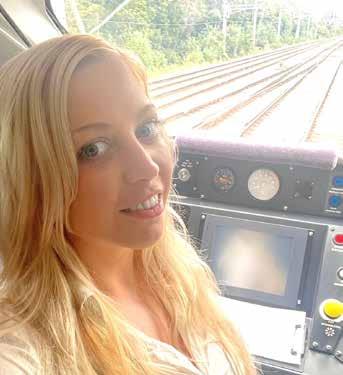
Beyond the leisure opportunities, rail also acts as an enabler for active and sustainable onward travel and journey connections for work, education, and more. Manchester’s Bee Network is an ideal example of this: connecting buses, trams, cycle hire, and walking routes with the wider rail network to ensure smooth and connected journeys.
At a national and regional level we must all ensure we focus on growing connectivity and multi-modal transport
© Transport for the North

opportunities, enabling communities to make the most efficient possible journeys.
The need to reduce car journeys and increase travel by public transport also has other health implications – research from the University of Oxford in 2018 found that pollution from cars and vans costs the NHS around £6 billion per year due to the negative impact on human health, and that these vehicles (largely diesel) are responsible for 10,000 early deaths each year. By encouraging and enabling use of public transport instead of car use, we can work to reduce these statistics and enable good health across our communities.
Beyond physical health, rail and good transport links can impact mental health. Research from ‘The Health Foundation’ in 2021 found that “people who rate public transport as ‘good’ are close to three times more likely than those who rate it as ‘poor’ to be able to access public services such as health care, food shops, or education. They are also slightly less likely to report feeling under strain, being dissatisfied with life, or experiencing mental health problems.”
Enabling access to basic services as well as a range of opportunities is central to happy and healthy communities, and it is vital that transport providers assess where gaps in provision exist and work to close these.

With these needs in mind, Transport for the North has launched a new visualiser tool and report revealing where community severance is most likely to be experienced when accessing key, basic services. Community severance is a term which outlines how infrastructure can act as a barrier to movement, impacting people, behaviours and perceptions, and the environment, and can include a lack of information provision, a lack of accessibility, unreliable services, and more.
Through this work, it found that 12.6 million people in England live in areas which are at higher risk of experiencing community severance; roughly 22.3% of the English population. This tool will enable Transport for the North to support its local partners and work with transport providers to understand the impact of community severance, as well as to continue its work of enabling an efficient and accessible transport across the North which meets the needs of all.
Marginalised communities often also have lower levels of access to public transport and rail. A 2019 Government Office for Science report, ‘Inequalities in Mobility and Access in the UK Transport System’, found that reduced mobility and access to public transport highly correlates with social disadvantage, and that some community and social groups are at

higher risk of being isolated in this way than others are. For example, it found that car owners are the least mobility constrained, but that there are considerable affordability issues with car ownership with many lower income households.
The lowest income households have higher levels of non-car ownership, with female
heads of house, young and older people, black and minority ethnic (BME) and disabled people concentrated in this quintile. People living in disadvantaged areas also tend to have greater proximity to fast-moving traffic and live with higher levels of exposure to road traffic risk as well as to traffic emissions.
As outlined earlier in this article, Transport for the North recognises the need to reduce car ownership for environmental and health reasons, whilst still ensuring connected communities. This clearly highlights the need for targeted public transport improvement interventions, in line with Transport for the North’s community severance tool findings.
Access to public transport and to rail is central to happy, healthy, and flourishing communities, and projects and programmes of work in transport must be based on evidence centred on empowering marginalised and isolated groups. It is essential that we continue to collaborate and research regionally, nationally, and internationally to enable safe and efficient transport for all.
Daisy Chapman-Chamberlain is specification manager at Transport for the North. She focuses on improving transport systems, accessibility, safety, and beyond. Daisy can be reached at daisy.chapmanchamberlain@transportforthenorth.com or via LinkedIn.
There has been some late or maybe lack of reporting of trapped and dragged incidents by London Underground. Some time ago trams were all too often involved in similar incidents. Most seem to be the result of individuals trying to beat the closing doors.
At this time of year, vegetation growth may damage structures by spreading roots. In many places sighting distances are compromised and even experienced track workers may underestimate minimum warning times.
Heritage Railways are a national success story but operating them poses its own challenges as is evident from the collision on the Strathspey Railway involving the Flying Scotsman. Other heritage railways would do well to scrutinise their operations in the light of the RAIB report.
Over speeding at Spital Junction Peterborough has now involved three train operating companies resulting in four additional Rail Accident Investigation Branch (RAIB) recommendations which hopefully will prevent further incidents.
Pram hits train at Banbury
On 8 June at 12:36, a Reading to York passenger train entered platform 2 at Banbury Station where it was due to stop. As it arrived, a parent and a relative of an infant child in a pram
were waiting behind the yellow line with luggage. The parent momentarily let go of the handle of the pram which then rolled towards the platform edge. It made contact with the bodyside of the train’s second coach while the train was still travelling at an estimated 35 mph. The pram spun, tipped over, and the infant fell onto the platform sustaining a minor head injury. The RAIB has decided to issue a Safety Digest about this accident.
A passenger was trapped and dragged on 17 July at Enfield Town Station. At 18:07 that evening the passenger attempted to board a train as its doors were closing. The train set off with the passenger’s hand trapped in its doors. The passenger ran alongside the train
but soon lost their footing. Other passengers alerted the driver who then stopped the train and released the doors. During the incident the train reached 11mph and travelled around 60 metres. The RAIB says that the passenger suffered “minor physical injuries and psychological distress”.
Arms near miss
This near miss involved an engineering train and a heavy goods road vehicle at the manually controlled level crossing at Craven Arms. At 10:00 on 22 July, the train was signalled across the crossing while the barriers were raised leaving the crossing open to road vehicles. The engineers' train narrowly missed hitting the heavy goods road vehicle. No one was injured and no damage was caused.
RAIB will issue a Safety Digest.



Trains damaged at Kings Langley
On 25 April at 06:43, a train ran into an object on the track at Kings Langley. The Wolverhampton to London train struck part of a road/rail access point (RRAP) that had been left on the track. The RRAP had been used the previous night when overhead line work was carried out. Debris and track ballast struck a second train travelling in
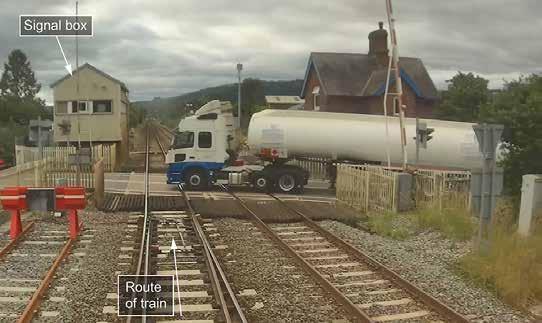


the opposite direction and some also landed on Kings Langley Station platforms. Fortunately, they were unoccupied at the time. The resultant damage to both trains meant that neither of them could continue in service but neither of them was derailed.
The temporary RRAP had been used for overhead line work. Part of it became lodged under a passing train causing a braking pad to become loose. The detached pad hit another train travelling in the opposite direction. The Person in Charge of Possession (PICOP) was located at the former Watford Junction
Signal Box for the 20-mile-long possession. A mobile engineering supervisor managed the relevant work site, and the relevant Controllers of Site Safety (COSS). The overhead line work needed two Mobile Elevated Work Platforms (MEWP). The temporary RRAP consisted of four pieces placed outside the running rails and three between the running rails. Four similar sets were set up to provide the necessary eight metres length. Individual pieces weigh up to 25kg and are manually lifted by two workers, providing an eight-metre longRRAP.
The work team of 11 included both Network Rail and contractors’ staff. Each MEWP had a machine operator and a controller. Four people were to work from each MEWP together with a manager in charge to track the progress of the work. However, high ballast levels on the Up Fast were “outside the RRAP manufacturer’s installation guidelines” but the team had no shovels with which to reduce the levels. The RAIB report says that the temporary RRAP was probably installed at too high a level.
CCTV from one of the train’s shows a piece of RRAP some 40 metres south of where it was installed. After the work was completed the MEWP’s returned to the access point at 03:00 hours. The MEWP on the Up Fast derailed on the temporary RRAP.
The workers removed remaining pieces of RRAP which were loaded into a flatbed lorry. No component part counts were made to ensure that all 20 parts of the RRAP were accounted for. At 03:15 the PIC confirmed to the engineering supervisor that the line was clear and safe and handed back the worksite. The possession was then given up and train working resumed.
On 5 September, RAIB published its report on this accident which happened at 18:05 on 29 September 2023. The Flying Scotsman steam locomotive travelling tender first collided with its livered coaches on the approach to platform 3 at Aviemore Station. The coaches are used on the mainline railway but were to be hauled on the Strathspey Railway by the Flying Scotsman as part of a planned movement to Boat of Garten Station.
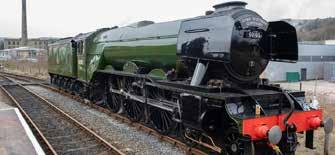
The collision at just 7mph happened as the locomotive was moving to be coupled to the coaches. Two people were injured and taken to hospital. There was damage to the tender and the coaches were taken out of service.
RAIB’s report 09/2024 says that the impact caused the leading coach buffer to become locked with the gangway of the locomotive tender. Four coaches were damaged internally with “broken and detached fittings” and “bottles of wine and spirits were dislodged from racks and shelves” as the picture shows.
The RAIB report states bluntly that “the Strathspey Railway Company did not effectively manage the visit of the Flying Scotsman”. The report includes three detailed action recommendations which have already been adopted. Under the heading of ‘Other Actions’ the report includes the comment that “the way in which wine bottles are stored has been modified”.
The report by RAIB identifies “Causal Factors” including the “ambiguity of roles within the cab” and the perception that “the custodian’s representative was looking out and providing direction to the driver when they were not so doing”. Immediately before the collision, the custodian’s representative realised that the locomotive was about to collide with the coaches and shouted a warning just as the driver saw the coaches coming into view. At that time there were six people in the cab of the Flying Scotsman.
RAIB has recommended that Strathspey Railway Company “make any changes needed to its organisation rules and procedures”. Also, it is required to review the implementation of its new standard operating procedure to manage special events and special train planning to ensure it is effective in identifying, assessing, and mitigating the risks associated with such events.
In mid-August, RAIB published its Safety Digest of this near miss which occurred at Littlehempston, Devon, on 13 March. At 10:44 a passenger train travelling at 54mph had a near miss with the Controller of Site Safety (COSS) who was with a group working using a “separated system of work” which may be used provided individuals remain “at least two metres away from any open line.” The near miss took place on the Paddington to Penzance line near Littlehampton.
The COSS and five track workers were provided by PACE Infrastructure Solutions to Colas Rail. The line has a speed restriction of 60mph reducing to 55mph just past the site of the near miss. Colas had identified minor faults in a section of troughing which were to be corrected using track possessions. However, it had been unable to obtain mid-week possessions, so the works were planned using a separated system with trains running on both lines.

The COSS received two packs: one using separated working and the other for prebooked line blockages. Colas told the RAIB that they expected the COSS to use the separated option but, if moving nearer than two metres of the line became necessary, work would be stopped, the areas marked, and work completed with the line blocked.
The COSS became aware that the distance between the troughing and the nearest rail was reducing so went ahead southwards to check if the group could continue under a separated system. The COSS became remote from the group so there was no one close enough to warn of an approaching train.
On-train CCTV images show that, due to overhanging vegetation, the COSS was obscured from the train driver’s view until only five seconds before the train passed. The COSS moved clear with just two seconds to spare. The driver reported the near miss to the signaller. The Rule Book is clear and specific: “the COSS is mandated to remain with the work group to advise and observe personally at all times”.
On 16 September, RAIB released its report 10/2024 on this incident which occurred on 4 May last year. At 09:54, the Grand Central Sunderland to London Kings Cross passenger train went over three sets of points at the excessive speed of 66mph. The permitted speed is 30mph reducing to 25mph. Passengers were thrown from their seats and received minor injuries.
The report says the driver’s expectation was for the train to be routed straight ahead and that “driver awareness was not sufficient to overcome the expectation”. RAIB found that Network Rail and East Coast Mainline train operators “did not effectively control the risk of overspeeding when signalling was changed in 2013” and that, following a similar

incident in April 2022, Network Rail does not control the risk where there is a long distance between the approach signal and the junction once a proceed aspect has been given.
RAIB has made four recommendations:
• Grand Central is to review and amend its training and competence management process to provide its drivers with the necessary non-technical skills or additional strategies to manage the risk at signals showing different aspects to those usually encountered.
• Network Rail and train operators are to review the processes by which they derive, share and implement safety learning from accidents and incidents.
• Rail Safety and Standards Board (RSSB) are to review the standards specifying relative brightness of main aspects and junction indicators to understand the effects on conspicuity of the complete signal up to the maximum distance at which the signal is required to be readable.
• Network Rail is to manage the risk of a driver not seeing a route indication because of the gradual reduction of light output of LED signals which reduces over time.
RAIB Chief Inspector Andrew Hall summed up the situation, stating that: “An underlying factor behind this incident was that neither Network Rail or the East Coast Mainline Operators effectively controlled the risk of overspeeding at Spital Junction both at the time the protecting signal was changed in 2014 or following the previous incident in 2022.”

Matthew Moxon, head of talent acquisition at Northern, joined the rail industry in September 2023. He talks to RailStaff about his experience of working in Rail, the unique challenges of recruiting into the industry, and how to make the process more accessible for everyone.
Thanks for joining us, Matthew. To start, would you mind giving us an idea of what your role as head of talent acquisition involves?
I’ve been head of talent acquisition since September 2023, so that’s 12 months now. My role at Northern covers everything we do to attract potential candidates, both externally and internally. That covers the process of assessing candidates, developing our Employer Value Proposition (EVP) candidate follow-ups, all the way through to the offer-management stage and onboarding.
There’s a lot to do in terms of attracting and retaining colleagues, including the advertising and recruitment marketing channels we use to get that message across, and also the many events we attend to attract graduates, apprentices, and year-in-industry cohorts. We’re currently looking at all the other areas from which we can draw candidates including, for example, ex-offender programs, as well as attracting ex-armed forces and exservices personnel.
Going forward, we’ll be examining how we develop our employer value proposition, or rather what it’s like to work at Northern and what we can offer to people considering a career within our organisation.
Your career to date has spanned a number of industries. In your opinion, how does the recruitment environment in rail compare to others and what trends are you seeing?
I think that the appeal of jobs in rail, aside from the traditional roles such as train driver, is quite low. There aren’t many people who are necessarily considering rail as a career, and potential candidates tend to be attracted

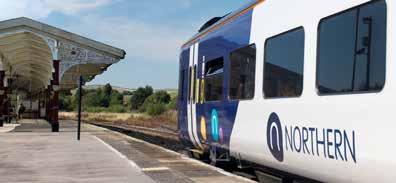
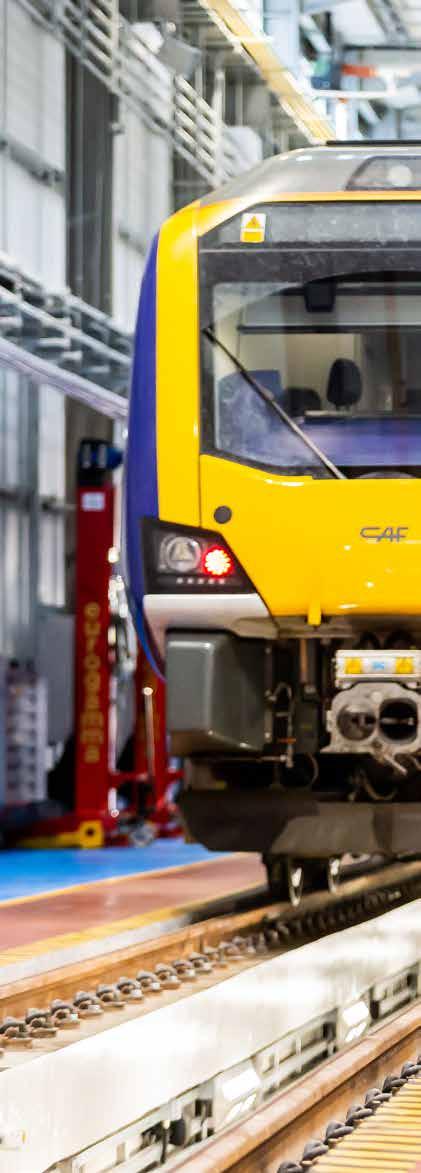
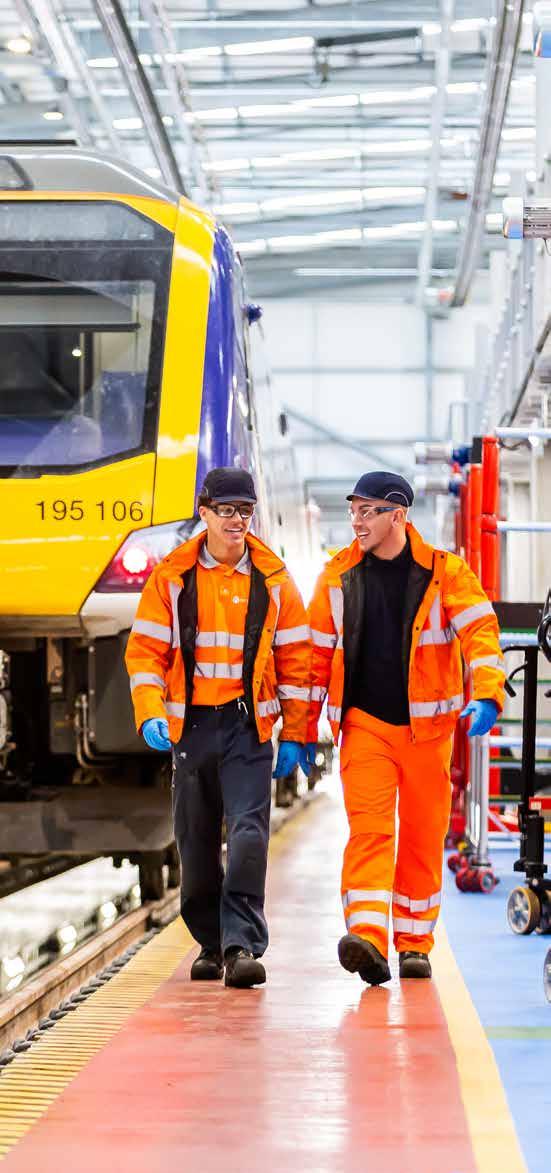
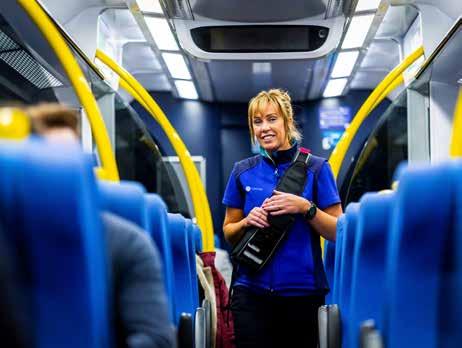
by some of the more obvious big brands without necessarily realising the breadth of opportunities available in our industry.
In terms of trends, there’s a move toward what we call ‘skills-based’ hiring, as opposed to just basing decisions on a CV. CVs are almost like window shopping – they only give you a snapshot of an individual and don’t tell you everything you need to know. We've got to come up with processes that demystify that pretty quickly, and having the right assessment tools for the right role is paramount to successful recruitment.
It’s important and we do not dismiss people’s prior achievements, but these don’t always relate to success in our business. We need to scrutinise and test candidates a little bit more. This is all moving forward holistically, and I think it will be the biggest evolution in recruitment over the next few years. We’re also looking at using AI and the technology to support that, making recruitment less subjective and actually a little bit more quantitative and evidence based.
It’s a really exciting time.
What challenges are recruiters working against at the moment and how are these being overcome?
We're still working against the backdrop of a skills shortage, particularly within technical disciplines. Looking at engineering, for example, it's so important to grow your own talent in this space. We have a very successful scheme where we take on 18 engineering apprentices every year and put them through quite a rigorous application vetting process, which includes an assessment centre where we get to test a number of different skill sets and behaviours. We had around 900 applications this year, triple the amount that we've had in previous years, and we’ve been able to select some very strong candidates.
One of our big challenges as a society is how to encourage more females to get into rail and engineering more broadly, and I think we need to start sowing the seeds for some of these roles as early as primary school level. We need to cut through some of those barriers and I think schools and parents/guardians can help to support that.
As with other roles, such as train drivers, some the blockers lie around shift patterns and a lack of flexibility on the part of companies. The new Government has recently announced that workplace flexibility will be made mandatory which is a positive step, but how will it operate when you've got to go to a manufacturing plant, to a construction site, or you need to get a train back on the tracks by a particular time? We need to find solutions to all of that if we’re going to encourage more female candidates.
We’re seeing a lot more counteroffers being made these days and that makes it more difficult for me as a recruiter to headhunt talent. As an industry, we really have to think about how we can draw talented people away from their current companies.
That said, businesses are becoming much more savvy when it comes to retaining staff, including offering better flexibility, greater benefits, and so on. Employers are becoming more clued up to the fact that it's not as easy to replace talent and it's very, very expensive to hire and reskill new staff.
Northern recently announced that it is reviewing its recruitment process with regard to neurodivergent candidates. Can you give us any further insight on this?
This initiative was fuelled primarily by people in the business coming forward with their own experience of how challenging the job seeking process can be for neurodivergent individuals. We've now set a working group alongside people with those lived experiences.
We’re working with our rail accessibility manager, who is himself neurodivergent, and is able to put himself in the shoes of candidates who face these types of difficulties. But there is no one-size-fits-all solution. Every individual has their own needs and set of challenges. However, we’re trying to make the process as easy and transparent as we can for people.
A few of the things were doing to make recruitment more accessible include providing a step-by-step breakdown of the process to make things really clear; providing candidates with images of the room in which interviews will take place so they’re comfortable with the surroundings when they arrive; allowing candidates to bring notes to interviews; and providing interview questions beforehand.
It's all about putting our cards on the table and taking the mystery out of the recruitment process, as well as tailoring the recruitment process to each individual candidate.
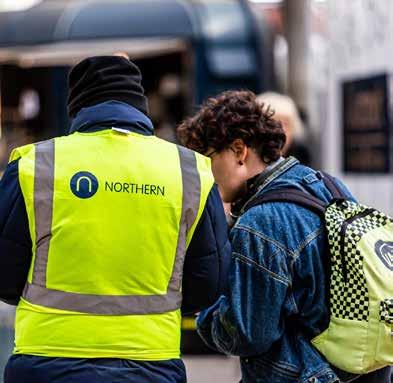
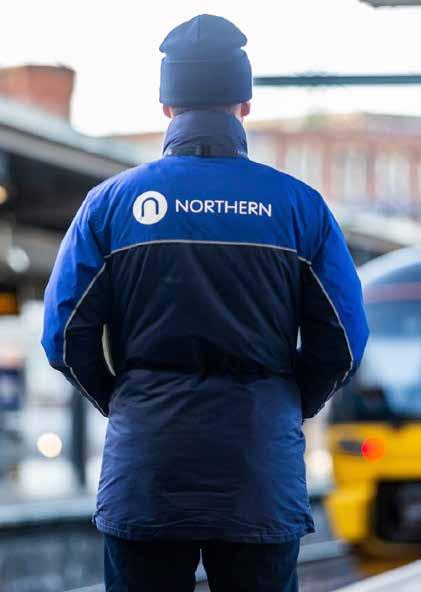
But it’s not just about recruitment. We also need to make sure that the environment is right for successful candidates when they arrive on their first day at work, and that we have the support and infrastructure in place to do that. We’ve been working with our Employee Experience Team and our fantastic EDI lead to ensure that we’re working hand-in-glove to get the best outcomes for candidates.
We’re at the beginning of this journey and it’s too early to give any data on it, but I think in a year or two we’ll really see the fruits of the work that we’re doing.
Finally, what makes rail a great choice for anyone at the start of their career or looking to switch industries?
Rail is an underrepresented opportunity for a lot of people but the diversity of careers on offer in this industry is unbelievable. There’s a particular interpretation of what a career in rail can be, whether that’s as a driver, as a conductor, as an engineer, but really there is a whole plethora of different roles and opportunities, and you can move in and out of different disciplines, if you have the right motivations and behaviours.
Since I joined the industry last year, I’ve been really encouraged by how collaborative it is. I've never worked in an industry where I'm involved in so many work groups, with so many different organisations, all trying to tackle similar challenges and make things better. That's a unique and positive experience, and one which should attract candidates who want to work to improve something that’s bigger than themselves.
I've worked in many different industries, and what I’d like to make clear is that in rail, the opportunities are real, no matter what level you enter the industry at. Here at Northern, for instance, we have a regional director who has worked in pretty much every role you can imagine within rail. The fact that 38% of the roles that we fill are with internal applicants shows that once people are in the rail industry, they're incredibly keen to stay and develop a career. As a recruiter, that is a really exciting thing to be a part of.

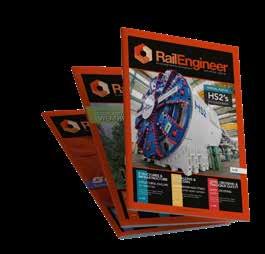








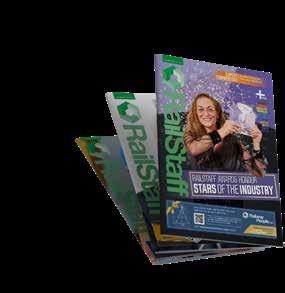
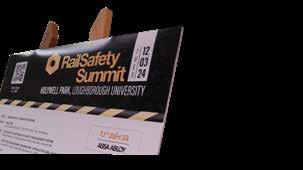
Connecting the UK rail industry for over 27 years.

THERE'S A CHILL IN THE AIR, THE NIGHTS ARE DRAWING IN, AND THE COUNTDOWN TO THE FESTIVE SEASON HAS BEGUN. BUT BEFORE WE WAVE GOODBYE TO 2024, THERE'S ANOTHER VERY SPECIAL DATE IN THE CALENDAR.
That’s right, it’s almost time for the RailStaff Awards!
Each year sees dozens of rail industry events, but the RailStaff Awards provides that extra something that no others can match. It’s the only awards ceremony devoted to the industry’s incredible employees and the entire evening is devoted to staff who go beyond their role.
Whether that’s by supporting their colleagues, providing excellent service, or putting something back into their community, the RailStaff Awards honours and rewards the individuals who do the industry proud.
The RailStaff Awards always provide an exhilarating evening and this year is no different with attendees able to sample New York’s glitz and glamour.
Guests arriving at Birmingham’s NEC can leave their coats at the Broadway ticket office and make their way towards the best that Manhattan has to offer. With beautiful bars serving a range of exquisite cocktails and entertainers offering impromptu performances, as soon as they walk in, guests can wrap themselves in the exciting atmosphere of a New York Christmas party!
Then, as guests take their seats for a sublime three course feast, the main stage bursts into life and all are treated to an evening of thrilling entertainment. Attendees will be dazzled by astounding aerial performers, heart-stopping high wire acts, fearless fire dancers, and a captivating grand finale.
TV star and all-round entertainer Brian Conley hosts this year’s event. Boasting a decades-long career as an actor, comedian, singer, and TV presenter, he is certain to entertain as he guides guests through the night’s proceedings.
Brian has starred in multiple award-winning television shows, most recently completing a two-year stint on soap favourite, Eastenders. On the stage, he has played the lead role in multiple West End musicals and as a musician,





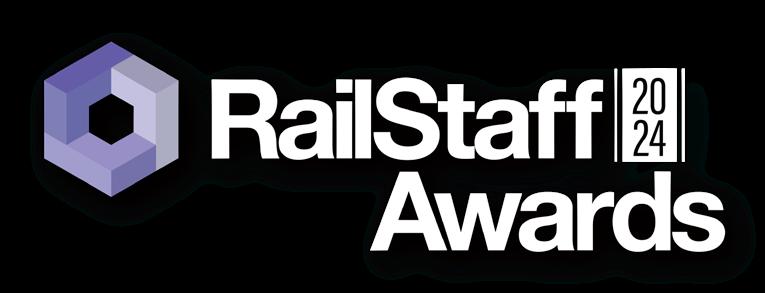





he’s released five albums, including Brian Conley Sings, Let the Good Times Roll, and Stage to Stage.
“I’m very proud to be hosting the RailStaff Awards at the NEC on 28 November”, says Brian. “It’s going to be an absolute extravaganza celebrating the wonderful work that the workers of the rail industry do.
“Put the date in your calendar and book it now!”
Brian will be naming the industry superstars who go beyond their role in the following categories:
• Apprentice of the Year Award
• Charity Award
• Customer Service Person or Team Award
• Equality, Diversity & Inclusion Person or Team Award
• Graduate of the Year Award
• Health & Wellbeing Person or Team Award
• HR, Recruitment & Talent Acquisition Person or Team Award
• Innovation & Technology Person or Team Award
• Learning, Development & Investing in People Award
• Lifetime Achievement Award
• Rail Engineer of the Year Award
• Rail Manager of the Year Award
• Rail Person of the Year Award
• Rail Team of the Year Award
• Rolling Stock, Freight & Depot Person or Team Award
• Safety Person or Team Award
• Lifesaver Award
• Station Staff Person or Team Award
• Sustainability & Corporate Responsibility Person or Team Award
• Rail Ambassador of the Year Award
Nominations are now closed, and the finalists will be announced on October 23.
With dinner over, and the awards ceremony drawing to a close, the night truly begins.
Fairground rides whirr into life, casino tables open, and the dance floor opens for those with energy to dance the night way.

Then, as midnight beckons, breakfast rolls are served to provide that final burst of energy to keep you dancing till the lights go up. The night is sure to be a party masterpiece – one that will be talked about well into 2025.
Attendees to the RailStaff Awards are guaranteed an amazing experience with delicious food, drink, and spectacular entertainment. So what are you waiting for? Dig out your glad rags and prepare for the night of the year. The industry’s biggest celebration is just weeks away.
Tickets for the RailStaff Awards are available now. Book today by following the QR code and make sure you don’t miss out.

If there’s one category at the RailStaff Awards with a little more weight than the rest, it’s the Lifesaver Award. While the nominees in every category are heroes, only those who are honoured with the Lifesaver Award can say they have pulled someone back from the brink. The Lifesaver Award recognises staff who have used all their skills and training to help save a life on the rails, and last year Megan Moore from ScotRail took the honour.

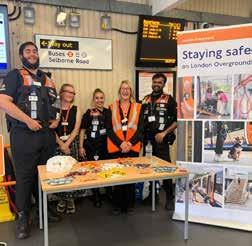
Megan was awarded for her quick thinking when she spotted a worrying message on social media from an unknown member of the public standing at a station. She engaged with the individual via social media and immediately applied her training. As well as raising the alarm to put a caution on the line, she also spoke directly to the staff at the station. Thankfully, an incoming train was brought to a stop and the individual was taken to safety.
This year, the Lifesaver Award is sponsored by security firm ResponSec Ltd which provides a wide range of security services across numerous industries. The company broke into the rail industry in 2019, working with Network Rail in the Southern region to help reduce anti-social behaviour. Not only did this move make good business sense, it was also something of a passion-project for Managing Director Daniel Blackwood.




“The company was initially set up to serve live music and sporting events in London and the surrounding counties, but in the last four years has been lending our expertise to the rail industry,” he says.
“But I’ve always been a bit of a rail enthusiast. I’ve always had a passion for it and helping to make the railways safer has been a dream of mine for some time.”
In recent years ResponSec has supplied travel safe and welfare officers for Govia Thameslink Railway, and safety, security and enforcement officers for London Overground. But the very nature of the work means that ResponSec is all too aware of the dangers of the railway.
“The rail industry is a difficult one to work in and there’s such a wide range of characters using the network,” says Daniel. “When you’re on a train you could be sitting next to a high-flying CEO, or someone down on their luck who’s having a really bad day. It’s a tough job for our staff because they’re never sure what situation will arise. No two days are the same, and security staff have to deal with a lot of unpleasant scenarios.”
PREVENTING TRAGEDY
Making the decision to sponsor the Lifesaver Award was an easy one, he adds.
“The Lifesaver Award is so important. During our time working on the railway we've dealt with a lot of lifesaving interventions and unfortunately seen the aftermath of suicide attempts. It’s always a tragedy when someone loses their life in this way, but it also has an impact on so many other people.”
“Many people make their way to the railway when they’re in distress, and sometimes it’s just a cry for help. But having people like our teams and other railway staff there to prevent a tragedy - to help diffuse the situation and point individuals in the direction of help - is critical.”
But it’s not just security staff who can make a difference. Anyone can reach out to someone who appears to be struggling. Just by saying hello, you could have a huge impact on somebody’s life and prevent the worst.
The Lifesaver Award is reserved for those heroes who take that step.





















New talent is the lifeblood of the industry. Every year, experienced and knowledgeable employees leave for pastures new or to enjoy a well-earned retirement. It is essential, therefore, that a supply of fresh faces is readily available.

But it’s not just about maintaining manpower. The younger generation brings novel ideas, different ways of thinking and, very often, experience from outside the industry. The Graduate of the Year Award, which makes a return for 2024, celebrates those newcomers who, fresh out of university, have made a significant impact on the industry they’ve recently joined. It recognises the outstanding contribution they make both professionally and to the wider community.
Back in 2022, Louis Szymanski of D2 Rail was honoured with the award. Louis joined D2 Rail in August 2020 and made a significant impact on the business in a very short timeframe.
Louis was nominated by his colleagues who were amazed at how quickly he’d made himself an integral part of both the D2 Rail Project Controls Team and the TransPennine Route Upgrade (TRU) West Alliance Planning & Controls Team. He proved very quickly that he was an extremely competent and adaptable professional, seeking out opportunities to extend his own development and impressing teammates with his dedication and compassion.



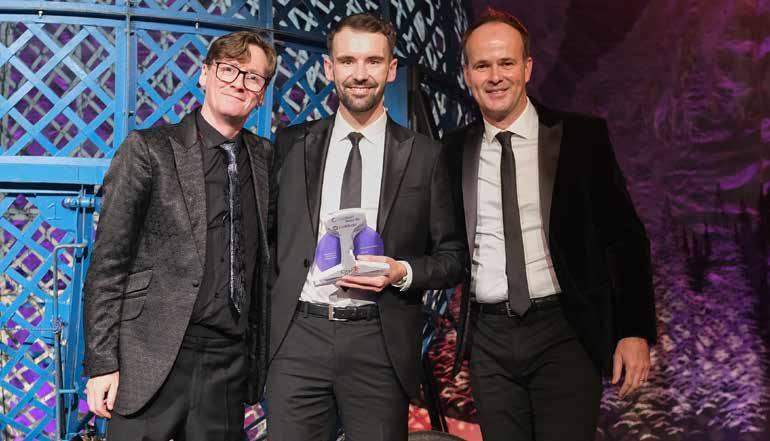
On top of this, Louis also founded D2 Rail’s Equality, Diversity, and Inclusion group, and volunteered on the TRU West Equality Diversity and Inclusion group as an ED&I Champion. He was a shining example of what new graduates can offer to the industry.
This year, train operator Heathrow Express supports the Graduate of the Year Award. Heathrow Express is a high-speed train service connecting London Heathrow Airport with Paddington Station in central London. Launched in 1998, it offers the fastest route between the airport and the city centre, with journey times of approximately 15 minutes. The service runs every 15 minutes, providing a convenient and efficient option for travellers.
Catering primarily to business travellers and tourists seeking a quick and reliable airport transfer, Heathrow Express is known for its punctuality and comfort. In its 26 years of operation, over 100 million passengers have travelled with the operator.
Heathrow Express is a great place to work with a wide variety of jobs on offer from front line roles in station or terminal to roles in head office. The company offers plenty of opportunities for graduates and is excited about attracting the brightest minds. It values the skills and experience that university leavers bring to the table and understands the contribution they can make to the industry.
“Heathrow Express is proud to support the Graduate of the Year Award, recognising the invaluable contributions that emerging talent brings to our industry,” said Commercial Strategy Lead Mark Eastwood. “As a company committed to innovation and excellence, we understand the importance of empowering the next generation of rail professionals.
“Graduates bring fresh energy, diverse perspectives, and cutting-edge knowledge, all of which are essential to driving the future of rail. We are proud to champion their achievements and support their journey as they help shape the future of the industry.”



The superb staff at Great Britain’s 2,500 railway stations face a multitude of challenges every single day.
With responsibilities ranging from maintaining cleanliness and safety, to assisting passengers with inquiries, selling tickets, dispatching trains, and much more, they’re expected to maintain a cheery demeanour, even when confronted by difficult customers.
This is why the RailStaff Awards proudly celebrates the frontline heroes who keep our stations running smoothly.
Aaron Koduah, who was born in Ghana and moved to the UK in 2004, lifted the Station Staff Award in 2019 when he was working on the gateline at Crewe station for Virgin Trains. He received 17 submissions from customers and colleagues for providing a ray of sunshine on even the dreariest of days and having a huge impact
on the customer experience.
He regularly wrote inspiring motivational messages on the station’s welcome board, which drew the attention of passengers as well as celebrities including Olympic cyclist Joanna Rowsell Shand and comedian and quiz king Paul ‘The Sinnerman’ Sinha. Aaron channelled this positive energy into publishing a book, Developing A Strong Mindset, which features a collection of his favourite quotes.
Winning the Station Staff Award has led to greater things for Aaron, who is now a train manger at Avanti West Coast, as well as a motivational speaker and life coach.
“Winning the 2019 RailStaff Award was a great privilege which continues to open up





new and exciting opportunities such as featuring in Avanti’s recruitment magazine, to winning Virgin’s Star of the Year Award,” says Aaron.
“The award was given to me by Sir Richard Branson, who selects 100 of the best employees from the 72,000 within the Virgin group of companies. Due to my exposure at the RailStaff Awards, I was selected as one of the 100 Virgin Stars of the year 2019.”
But it didn’t stop there. The awards kept rolling in, says Aaron.
“In 2022, my newfound exposure helped me to win another award back home in Africa where, after news spread of my RailStaff Award, I was nominated for the Africa Impact Makers Award, which I went on to win. The annual award honours Africans around the world who are achieving and inspiring others and I was so surprised to win as I faced some very tough competition.”
The Station Staff Award has boosted Aaron’s belief in himself, allowing him to advance his career at Avanti West Coast.
“The confidence the RailStaff Award gave me has encouraged me to develop myself and is a proud moment that I recalled during my interview for the role of train manager. The interviewer was aware of my achievements and the positive contribution I made to Virgin Trains / Avanti West Coast, as well as the wider rail network.
“The RailStaff Award has had a tremendous impact on my career. It’s made me feel very highly appreciated and inspired me to achieve more.” And that’s exactly what the RailStaff Awards exist for.


Exceptional service is expected of all of the railway’s customer-facing employees and the RailStaff Awards celebrate the teams and individuals who have truly excelled in meeting passenger’s needs with the Customer Service Award.
Southeastern’s Margaret (Maggie) Capps is the epitome of everything our judges look for in a winner, and after receiving an amazing 31 nominations she was awarded the top prize in 2019.
Maggie was nominated for her devoted service to Etchingham station in Sussex, where she brightens the village station with vibrant floral displays and is a part of the fabric of the community. Her expert knowledge ensures everyone is safe in times of disruption, and her calm, professional, ‘can do’ attitude means the single-manned station runs like clockwork. She puts her success down to really caring about the people she serves.
“Customer service is all about knowing the customer, she says. I have a personal relationship with each of mine. I know if somebody if upset or something is wrong. My customers share their lives with me, letting me know if they have a hospital visit, or if a family member has passed away. I’ve seen their children grow up and go on to do great things. It’s about being a part of their lives and part of the community.”
Indeed, one customer who nominated her for the 2019 Award, said they can get to London quicker via other stations, but they choose Etchingham because of Maggie.
Maggie is an advocate for the importance of singlemanned stations and, having worked at Etchingham for many years, she worries that their role is often overlooked.
“Our small stations are amazing,” she says. “But people don’t know enough about them. Not only do I run the station, sell tickets, and point people in the right direction, but the station also plays a key role in the local area.”
“When I won the award it was a huge deal for me. I didn’t think I had a chance because we’re a small station. I was so proud that my customers had taken the time to nominate me and that a station like Etchingham was getting the recognition it deserved.”

Maggie has stayed at Etchingham since winning the award, and even though she could now retire she prefers to continue working on a part time basis.
“I think you need something to keep your brain whirring,” she says. “Also, I didn’t want to lose touch with my customers, and they all encouraged me stay on.”
She continues to make sure the station is a hub of the community and it recently won second prize in the Southeastern in Bloom competition, a result of Maggie’s and the Etchingham community’s, hard work and green fingers.
Maggie is an inspiration, working beyond all requirements and making the customer experience a truly personal one.
She is the embodiment of everything the RailStaff Awards stand for.





In April 2024, Carlisle Support Services made the decision to stop using subcontractors for its core non-specialist roles in front-line security, events, and cleaning operations. The company stated that this move was part of its broader commitment to promoting ethical labour practices and aiming to elevate industry standards.
Margins are often low in the security industry which gives providers little flexibility to recruit and train staff in-house. As a result, they often rely on subcontractors to meet fluctuating demand. This in turn drives down pay rates to unsustainable levels, high staff turnover, and subsequently affects the overall quality of service delivery.
Aiming to steer the industry away from such practices, Carlisle decided to remove its diminishing usage of subcontractors. In doing so, the company invested heavily in staff recruitment and development across all operational levels and focused its attention on long-term workforce planning and mobility across contracts. This process involved gradual progress with mass training strategies, including the completion of ACT and SCaN training modules by all Carlisle team members by the end of 2024 to maximise in-house capabilities.
This move further solidified the company’s commitment to investing in people and creating a positive and

rewarding workplace, while providing exceptional security and FM services to its clients.
Carlisle Director of Rail Strategy Steve Cere says: “We believe that by investing in our people, we are investing in the future of our company and the rail industry as a whole. This initiative has already been transformative for our company, leading to better staff retention and a more cohesive and collaborative working environment.
“It has reduced risk, improved efficiency, and enhanced the overall quality of service.
“By understanding our people, their skills, and their suitability for various roles, we ensure they are fully trained, inducted, and provided with progression opportunities for a fulfilling career.”
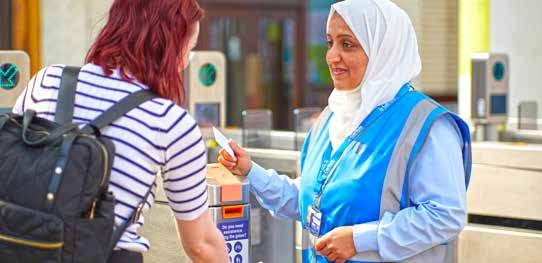

By prioritising employee growth and development, Carlisle cultivated a skilled and dedicated workforce, achieving unprecedented success in internal mobility. This year has seen:
• 47.5% of salaried roles filled by existing employees.
• 27.5% of these promotions come from frontline teams.
• 58% of new salaried employees transitioned from hourly paid positions.
"These figures highlight our success in creating clear career pathways and providing opportunities for our staff to advance within the company, says Steve."
"By nurturing talent from within, we foster a culture of loyalty, engagement, and high performance. Our employees feel valued and motivated, leading to increased job satisfaction and reduced turnover."
Removing reliance on external contractors has been a transformative move, allowing Carlisle to enhance quality control, improve efficiency, and ultimately deliver superior levels of service. It also presents new growth opportunities for employees, empowering them to take ownership of their work, which contributes to the organisation's overall success.
"By combining our focus on talent development with our commitment to self-delivery, we are building a strong foundation for the future," says Carlisle Support Services CEO Paul Evans.

"We are proud to be an industry leader in people development and security, and we look forward to continuing to grow and evolve as a company."
Carlisle hopes its leadership will inspire other industry leaders to prioritise ethical labour practices. By doing so collectively, self-delivery can become the norm, raising industry standards while minimising buyer pressures to reduce labour costs. Ultimately, this can help attract much-needed new talent to the industry.
Carlisle Support Services is an established supplier for the Rail industry with over 20 years’ experience in the sector. The company employs more than 2,300 frontline staff working across the full spectrum of customer-facing roles, including customer service, retail, revenue protection, cleaning, and safety-critical. Carlisle enjoys longstanding and highly successful relationships with the majority of the current train operators.
LIAM JOHNSTON, EXECUTIVE DIRECTOR OF RAILWAY MISSION, REMINDS US OF THE EFFORTS OF THE RAIL INDUSTRY DURING THE FIRST AND SECOND WORLD WARS, AND THE IMPORTANCE OF REMEMBERING THOSE WHO LOST THEIR LIVES.

Each November, the UK railway industry plays an important role in commemorating Remembrance and Armistice services, honouring the contributions and sacrifices made during the First and Second World Wars. The significance of this participation extends beyond simple tradition; it acknowledges the unique and critical role the railways played in these historic conflicts.

During both World Wars, Britain’s railways were pivotal to the war effort. Trains transported troops to the front lines, evacuated children from bomb-threatened cities, and delivered vital supplies such as munitions, food, and medical equipment. Railway workers themselves were heavily involved in the war, with thousands enlisting to serve in the armed forces. Many of these men and women never returned, and the railway industry lost a significant number of its workforce to the wars.
By actively participating in Remembrance and Armistice services, the railway industry preserves the memory of those employees who sacrificed their lives for their country. These acts of remembrance help ensure that the stories of railway workers and the broader impact of rail transport during the wars are not forgotten. They highlight the interconnection between industry and national service, emphasising the role civilian sectors can play in times of crisis.
Additionally, participating in these services fosters a sense of unity and respect within the railway community today, linking past and present generations. It also serves as a reminder to the public of the importance of the railway industry in the nation’s history, not only as a backbone of the British economy but also as a critical element in the nation's wartime resilience.
In taking part in these services, the UK railway industry shows respect for its past, while continuing to shape its future with the same spirit of service and dedication.
You can find a list of services that have been arranged on the Railway Mission’s website: www.railwaymission.org.
Railway Mission is a national charity which provides a regionally-based chaplaincy service and aims to be an impartial ‘friend’ to all those who work on the railway.
Regardless of faith, gender, sexual orientation or position in the industry, chaplains offer face-to-face year-round support, especially during an individual’s time of loneliness, stress, depression, bereavement or illness.
It offers pastoral care to the entire railway community and to members of the public affected by rail operations.
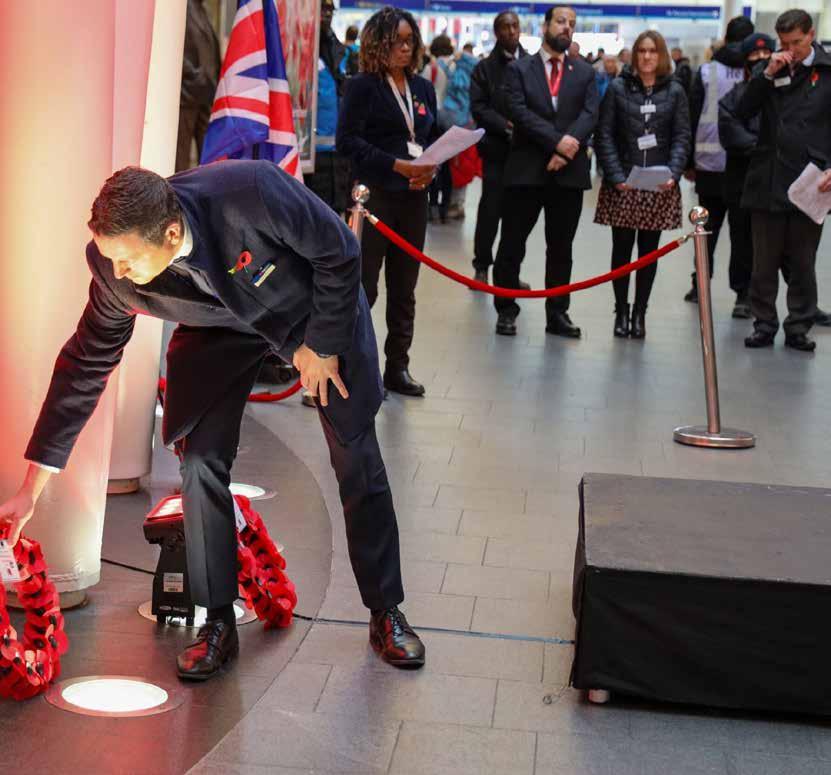

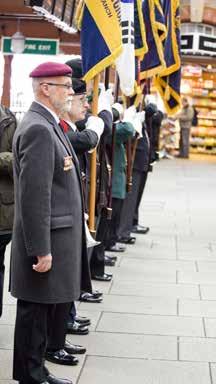

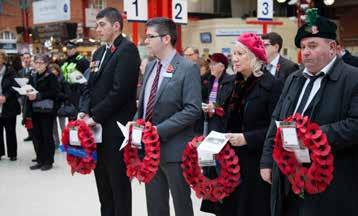
With just under three months to go until the start of a year-long celebration of 200 years of the modern railway in 2025, plans are being finalised to mark this historic milestone and explore rail’s past, present and future role in national life.
At an event in Darlington on 19 September, Jake Kelly, Network Rail Eastern region managing director, encouraged organisations and communities to embrace Railway 200, a once-in-a-generation opportunity to celebrate the railway’s far-reaching impact on how we live our lives and how it's shaping a more sustainable future.
The event announced the programme for a nine-month international festival across County Durham and Tees Valley from March to November next year, as part of Railway 200. Inspired by the opening of the Stockton and Darlington Railway (S&DR) on 27 September 1825 – a journey that gave birth to the modern railway – S&DR200 will present a series of free large-scale outdoor spectacles, events, exhibitions and new art commissions at world class venues.
Rail Minister Lord Hendy said: “Since the first passenger train entered service almost two hundred years ago, our railways have become integral to millions of lives, bringing communities closer together, opening up new opportunities for business and driving economic growth across the country.
“Railway 200 presents an exciting opportunity to unite the wider public in recognition of our rail network and the brilliant people who keep it running. I hope this year-long series of events and celebration encourages the next generation to consider a career in rail.”
The 200th anniversary will kick-off with an evocative ‘Whistle-Off’ of vintage locomotives at 12 noon on 1 January 2025 at sites across the UK, spearheaded by the Heritage Railway Association.
There will also be a national Railway 200 seat sale in early 2025, offering heavily discounted train travel for great days out, as announced this month by the Secretary of State for Transport.
Over three fun-filled days in August, train builder Alstom will host ‘The Greatest Gathering’ at its historic Litchurch Lane Works in Derby, showcasing the largest temporary assembly of trains and rail-related exhibits in a generation.
Other highlights include planning a touring exhibition train, named ‘Inspiration’, to crisscross Britain, creating a buzz at mainline stations, heritage railways and rail freight depots. The train is being developed in partnership with the National Railway Museum, part of the Science Museum Group. It will consist of different interactive exhibitions exploring the past, present and future of rail.
As well as celebrating the anniversary, the train aims to inspire schoolchildren and others to consider a career in the rail industry, shining a spotlight on the diversity of roles available for people from all backgrounds. It has been supported by a £250,000 grant from The National Lottery Heritage Fund.
At least 400,000 people - including school groups and families - are expected to visit the train. Its itinerary is being developed and will be confirmed early next year.






Elsewhere, other plans include:
• The National Railway Museum’s 50th birthday celebrations, including the summer re-opening of its refurbished and refreshed Station Hall.
• Railway 200-related activity, including a summer festival, at Locomotion museum in Shildon, on the route of the original Stockton and Darlington Railway.
• A Railway 200-themed Community Rail Week in May, from the Community Rail Network.
• A rail festival in Sussex from June to August, organised by the Bluebell Railway, which aims to attract more than 80,000 people, including 18,000 schoolchildren learning about STEM-related careers in the railway.
• A celebration and awards ceremony in London in July to coincide with the 150th anniversary of the Railway Industry Association, representing rail’s supply chain.
• Commemorative events at: the National Trust cottage in Wylam, Northumberland, where rail pioneer George Stephenson was born; Holy Trinity Church, Chesterfield, where he is buried; and Stephenson College, Durham University, where he is honoured.
These, and other events across the UK, are being publicised on a new interactive map on the Railway 200 website (www. railway200.co.uk).
Other activities include anniversary-related train namings, open days, heritage trails, rail staff and public events, commemorative books, exhibitions, competitions, school and public talks, steam shows, site visits, murals, quizzes, and charity fundraising.

Speaking on behalf of Railway 200, Jake Kelly, Network Rail Eastern region managing director, said: “Railway 200’s ambitious programme not only embraces the railway’s historic roots, but also looks to future innovations and how the industry adapts to modern-day challenges to get people and goods to where they need to be.
“Whether you are a frequent traveller, simply live by the railway, or are an engineer of the future, all are invited to take part in this huge programme of events, to celebrate the 200th anniversary of an invention born in the North East which has gone on to transform communities across the globe.”
Railway 200 is a partner-led programme of activities and events across the UK, supported by the rail industry, the UK Government, Transport Scotland, Transport for Wales, the Northern Ireland Executive, rail and business bodies, civic and community groups and a wide range of other partners, including Visit Britain and the Museums Association.
To register involvement in rail’s bicentenary visit www.railway200.co.uk/getinvolved For information about S&DR200 visit: www.sdr200.co.uk
As the CEO of Young Rail Professionals, I am thrilled to reflect on the remarkable experiences and insights gained at InnoTrans 2024, held in Berlin. This year’s event was not only a showcase of cutting-edge technology and innovation in the rail industry, but also a powerful platform for fostering connections among the next generation of rail professionals. It was also my and the YRP team’s first visit to Berlin.
InnoTrans is a pivotal event for the rail sector. With over 3,000 exhibitors from around the globe, the exhibition halls buzzed with energy and enthusiasm. It was inspiring to see how companies are pushing the boundaries of technology, from advancements in electrification and automation to the integration of digital solutions that enhance operational efficiency and passenger experience.
The rail industry is at a critical juncture, and the commitment to reducing carbon footprints was palpable. Many exhibitors showcased innovative solutions aimed at achieving netzero emissions. As young professionals, we are particularly excited about these developments as they align with our values and the future we envision for the industry.
For us at YRP, a significant highlight of InnoTrans 2024 was the emphasis on youth engagement and professional development. Some of our corporate members and industry partners kindly provided YRP the space to exhibit and network with their clients. Such events included the AtkinsRéalis executive dinner; The Young Rail Professionals’ networking event held with Railway Gazette; and the YRP talk on ‘What do we need to do to prepare and attract the skills of the next generation?’ at the AtkinsRéalis stand.
The talk attracted a diverse group of attendees eager to hear the YRP’s perspective and it was heartening to see established, senior industry leaders actively engaged in
the perspectives of young talent, fostering an environment of collaboration and knowledge exchange. The insights shared by both seasoned professionals and emerging leaders underscored the necessity of a united approach to tackle the evolving demands of our industry and the oncoming skills chasm.
YRP was hosted at the British Embassy by RIA, where the YRP CTO and National Secretary attended the reception to mix with other corporate members and key industry players to discuss the YRP agenda.
As we move forward from InnoTrans 2024, it is clear that the rail industry is on the brink of transformative change. The innovations presented at the event are not just trends; they represent a shift towards a more sustainable,



efficient, and inclusive future. How the industry responds to this change will decide who enjoys the feast this innovation provides, and those who survive in the famine of the future talent responding to the rail industry’s need for the next generation with the skills of the future.
At Young Rail Professionals, we are committed to being at the forefront of this evolution. We will continue to advocate for the involvement of young professionals in shaping the future of rail, ensuring that our voices are heard and our ideas are implemented.
As we reflect on the insights gained from InnoTrans 2024, it is essential to highlight the profound benefits that arise when senior industry figures actively include junior team members in discussions, decision-making processes, and networking opportunities. This


approach not only fosters a culture of diversity and inclusion but also enhances effectiveness and innovation within the rail sector.
Diversity and inclusion are not merely buzzwords; they are essential components of a thriving workplace. When senior leaders prioritise the inclusion of junior team members, they create an environment where diverse perspectives will flourish. This diversity of thought is crucial in an industry that is constantly evolving and facing new challenges.
By engaging younger professionals, who often bring fresh ideas and different viewpoints, senior figures can drive innovation and creativity. YRP has many senior industry figures who are generous with their time to assist with the YRP agenda. Personally, I would like to see InnoTrans 2026 and other industry conferences have senior industry figures taking along a junior counterpart as standard practice, something culturally we need to change as an industry. We at YRP would like to see a future where it becomes standard practice that all senior industry figures have a ‘shadow’ junior staff member in attendance with them.
Moreover, a diverse workforce reflects the communities we serve. The rail industry must cater to a wide range of passengers, and having a team that mirrors this diversity ensures that we are better equipped to meet their needs. By including junior team members from various backgrounds, we can develop solutions that are more inclusive and accessible, ultimately enhancing the passenger experience.
One of the most effective ways to foster inclusion is through reverse mentoring, a practice where junior team members mentor senior leaders. This dynamic not only empowers younger professionals but also provides senior figures with valuable insights into emerging trends, technologies, and the expectations of the next generation of workers and consumers.
At InnoTrans 2024, we witnessed numerous discussions around the importance of reverse mentoring. Senior leaders who embrace this practice can gain a deeper understanding of the challenges faced by younger employees, including issues related to work-life balance, mental health, and career aspirations.
Inclusion also opens the door to invaluable networking opportunities for junior team members. At events like InnoTrans, the chance to connect with industry leaders is a game-changer for young professionals. When senior figures actively involve junior team members in networking events, they not only help them build essential relationships but also instil confidence and a sense of belonging within the industry.
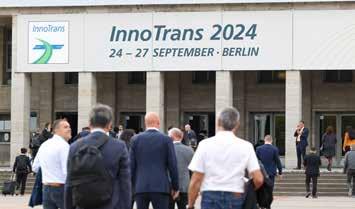
These networking opportunities can lead to mentorship relationships, collaborative projects, and even job offers. For junior professionals, having access to a network of experienced industry figures can be instrumental in their career development. It allows them to learn from the successes and challenges of others, gain insights into different career paths, and discover potential opportunities that they may not have considered.
To truly harness the benefits of including junior team members, senior industry figures must commit to creating a culture of inclusion. This involves actively seeking out the opinions and ideas of younger professionals, providing them with platforms to share their insights, and recognising their contributions to the organisation.
As we move forward in the rail industry, let us embrace the power of inclusion. By valuing the perspectives of junior team members, we can cultivate a more innovative, diverse, and resilient workforce. The future of rail depends on our ability to collaborate across generations, and by doing so, we can ensure that our industry not only meets the challenges of today but also thrives in the years to come.
In conclusion, the benefits of including junior team members in discussions and decision-making processes are manifold. By fostering diversity and inclusion, embracing reverse mentoring, and providing networking opportunities, we can empower the next generation of rail professionals to lead with confidence and creativity. Together, we can build a brighter future for the rail industry.
InnoTrans 2024 has reaffirmed my belief in the potential of our industry and the vital role that young professionals will play in its future. Together, we can drive the change needed to create a rail system that is not only innovative but also sustainable and accessible for all.
Network Rail has announced that Mona Sihota, head of drainage and lineside, has been appointed as president of the PWI.
Mona brings over 35 years of experience working in the railway industry, including 22 years at Network Rail, and has led projects in design, construction, and asset management. In 2016, she became Network Rail’s first head of drainage, responsible for overseeing the management of the whole of the rail network drainage infrastructure.

Mona said, “I am very honoured. The PWI dates back to 1884 and steeped in railway history. It now offers me a unique opportunity to collaborate with industry leaders and drive forward initiatives that will shape the future of railway infrastructure.
“For me, the impact of extreme and adverse weather on our railways has been profound. I know from firsthand experience that the industry cannot work in isolation. Fostering collaboration and sharing innovations is key to improving and creating a more efficient and sustainable railway network that will ultimately enhance the industry's resilience to climate change.”
Mona, who previously held the post of deputy president of the PWI, assumed the presidency in July and will serve a one-year term.
The PWI provides technical knowledge, advice, and support to the rail industry worldwide and works closely with leading organisations and government bodies, influencing and directly impacting industry training, management and competency standards.
Northern has appointed Chris Clarke as its new head of operational delivery in the North West.
Clarke, from Stockport in Greater Manchester, has previously spent 13 years working at Transport for London (TfL).
At TfL he was responsible for resource planning of the 6,000-station staff on the London Underground as well as leading on major IT projects for the operations team. He also spent five years as operations manager for the Victoria line.
Clarke made the move to Northern in January 2022, joining the train operator as a disruption controller before becoming regional improvement manager in August 2022.
Commenting on his appointment, Chris Clarke, commented: “I’m really enjoying

Accomplished sustainability manager Riona Ainge has been appointed to lead Systra’s sustainability efforts, focusing on reducing carbon footprint and broadening social value.
The role has been created to support Systra to deliver the four key pillars within its sustainability
mission; social purpose, climate action, responsible business, and environmental stewardship.
Riona joined Systra four years ago, starting as a consultant in the Planning and Consents Team on the Main Works Civils Contract for HS2. She was then seconded to the role of sustainability manager for the Balfour Beatty Vinci Systra JV, working on the delivery of Old Oak Common Station (OOC).
She is part of the Next Generation Leadership Team (NGLT), sitting alongside other early career professionals to bring new perspectives and challenge to the business, and was a finalist for the Women in Construction and Engineering (WICE) Awards in 2024 and the prestigious Young Railway Professional of the Year 2023.
David White, director of Health, Safety, Security & Sustainability at
Systra, said: “Riona’s appointment marks a step-change in the future of our sustainability mission at Systra.
“She brings a wealth of expertise and enthusiasm to this important role, and it is clear she is determined to drive genuine change and momentum across the business. I am very much looking forward to working with her on taking our sustainability mission forward.”
Riona added: “I am delighted to take on this important role for Systra, which aligns with my core values towards enhancing the environment and generating social value in our projects.
“My first priorities will be establishing our carbon management programme and creating distinct opportunities to deliver meaningful and lasting social value in the communities we serve.”

my time at Northern.
“The North West represents a huge part of the Northern network and I’m looking forward to getting stuck in and helping to improve service reliability for customers.”
Heathrow Express, has named Aoife Considine as its new business lead.
A chartered engineer, Aoife previously worked at Heathrow Express between 2018 and 2020 in the role of professional head of engineering. In this role she oversaw the safe maintenance of the previous fleet of trains, managed the leasing of trains to TfL Rail prior to the introduction of the Elizabeth Line, and supported preparations for the closure of Old Oak Common depot.
After earning her MBA from Imperial College London, Aoife returned to Heathrow in May 2023 as head of commercial strategy & planning, where she led capital investment initiatives.
Aoife said: “I am thrilled to be returning to Heathrow Express. Having worked closely with the team in the past, I’ve seen first-hand their commitment to innovation, safety, and providing an exceptional service to our customers, whilst continuing to enhance the customer experience and drive forward new opportunities for growth.”

Carlisle Support Services announces the appointment of Allan Gregory as the new director of transport security and policing. After recently retiring from his role as the assistant chief constable for British Transport Police (BTP), Allan joins Carlisle to provide subject matter expertise to further support its well-established client base within the rail and transport sector.
With 32 years of experience within BTP, Allan brings a wealth of expertise within the industry having been responsible for operational performance across England, Scotland, and Wales. He also oversaw volume crime investigation, community and stakeholder engagement, use of force, stop search, custody operations, the Special Constabulary, and neighbourhood policing.
In his new role at Carlisle, Allan will work
closely with the company’s director of rail strategy and the senior security and policing advisor to deliver a National Transport Security and Policing Solution. As a result, he will serve as the primary liaison with key stakeholders such as the Department for Transport, Home Office, Security Industry Authority, and more.
Allan has a strong track record of collaboration between policing and security resources in relation to the UK’s railway network and this experience will be paramount to tailoring Carlisle’s approach to policing within the transport industry.
On his appointment, Allan said: “I am delighted to be joining the Carlisle Support Services family. I am eager to learn, and it will be really interesting to see the UK’s railway network from a different perspective. I want to draw on my experience in policing in order

to support Carlisle’s focus on the sector. I look forward to meeting the operational teams, our customers, and other key partners.”
Govia Thameslink Railway (GTR), has announced that John Gerrard has been appointed as its chief finance officer (CFO) and will begin the role in November.
John will bring significant experience to GTR – he is currently lead finance director at Great British Railways Transition Team (GBRTT). There, he has been responsible for leading the team that has created new, whole industry financial tools and insight so that, for the first time, industry leaders can see the full picture on costs and revenues, including how they interact with each other across the system.

Within GBRTT he has also been a member of the fares, ticketing and rail reform Programme Board providing support and steer. He has also held a number of senior roles during 15 years at Network Rail.
Ralph Pidlsey, GTR’s current CFO, will retire this week. Having joined GTR in 2022 Ralph has been instrumental in supporting GTR’s recovery following the global pandemic.
Angie Doll, GTR’s chief executive officer, said: “I’m delighted to welcome John to GTR. He’s had an impressive career and will be a great addition to my team and the wider organisation. Not only are his technical skills excellent, but John is a natural collaborator with a keen eye on getting the best value for the customer.”
John said: “As a customer of GTR I’m very familiar with its services and I’m proud to join and be a part of the UK’s biggest railway operator. It’s a very important time for the industry and there’s a great opportunity for GTR to show how it can innovate to deliver value for money for customers as well as financial sustainability. I’m looking forward to meeting my new colleagues who I know work incredibly hard to serve their customers, and I’m excited at the prospect of using my skills and experiences to help improve GTR’s services for the hundreds of thousands of customers who use them.”




Martin Beable has joined Greater Anglia (GA) as its new managing director. He returns to the company from Transport UK, where he has been the new trains and fleet director since October 2023.
Martin previously spent nearly five years as GA's engineering director, where he helped to oversee the full fleet replacement programme and boost performance. He also led the upgrades for key train maintenance depots at Ilford and Norwich Crown Point and secured excellent commercial relationships with suppliers.

Commenting on his return to GA, Martin said: “I am delighted to be returning to GA as its new managing director. With new trains right across our network and industry-leading punctuality, we are well placed to keep on improving rail services for customers and communities throughout our region.
"Everyone at GA is committed to delivering the best possible service, day in, day out, and I am passionate about the role the railway plays in ensuring East Anglia is a successful and sustainable place to live and work.”
Martin succeeds Jamie Burles, who is taking on a new role at Network Rail's Eastern Region.
Jamie said: “I am proud to have been part of a great team at GA which has delivered a transformation in train services in our region over the past decade. We made a commitment to a positive step change in service quality, with new trains and better performance, and we have fulfilled that pledge.
“I am sure Martin Beable will maintain that cycle of continuous improvement, to provide even better services for passengers.”


The Transport Secretary has appointed Laura Shoaf as chair of Shadow Great British Railways (SGBR).
In the role, Laura will help drive the Government’s overhaul of the railways, bringing senior leaders together to deliver improvements for passengers and work towards a more unified rail system. SGBR will also help design Great British Railways.
Before leading the WMCA, Laura was managing director of Transport for West Midlands where she oversaw a multi-millionpound transport investment package for the region. She was the first female chair of the Urban Transport Group, which comprises transport leaders from across the UK, and supported the industry on its recovery from the Covid-19 emergency.
A recognised expert who has advised on national policy, Laura was also one of the UK’s
first Transport Champions for Tackling Violence Against Women and Girls. Her experience will be key in making the rail network more accessible and safer for all passengers.
Transport Secretary Louise Haigh said: "Establishing Shadow Great British Railways is a significant step towards delivering a unified railway with passengers at its heart by bringing together track and train - and it’s fantastic we have someone of Laura’s calibre to drive forward reforms.
Laura said: "I recognise the great power that our transport network plays in our day to day lives, but in order for it to work, and in order for it to keep opening up these opportunities, it has to be built around our passengers and freight users.
"It is my privilege to have been asked to chair Shadow Great British Railways, and my focus will be ensuring people are at the heart of the railways and to ensure this remains a focus for

years to come.”
As chair, Laura will be tasked with ensuring SGBR's leadership drives forward plans for improvement and challenging industry to deliver, while ensuring the interests of passengers, freight users and taxpayers remain at the forefront of everything SGBR does.
James Richardson has been announced as the new managing director of the Transpennine Route Upgrade (TRU), the multi-billion railway electrification scheme delivering faster, cleaner and greener journeys for millions of people across the north of England.
Highly experienced in major programmes, James is currently managing director of the Skanska Costain STRABAG joint venture delivering the HS2 London tunnels.
James said: “Leading this ambitious infrastructure programme of national importance is a huge source of pride for me. It will benefit millions of people by improving the connectivity between towns and cities.
“TRU is making fantastic progress and already demonstrating how complex infrastructure can be delivered safely and efficiently. I can’t wait to get started working with such

talented teams and individuals in order to see that continue to develop.”
Welcoming James, Rob McIntosh, Network Rail’s North West and Central managing director, said: “Given the scale of our works - one of the biggest programmes in Europe and carried out on a live railway - I am really happy we’ve appointed a very capable leader who can manage our unique challenges and lead TRU to continued success.”
James will take up his post on TRU in the new year.
Hannah Lindsay has become Govia Thameslink Railway’s (GTR) first ever security improvement manager.
Hannah joined GTR as a rail enforcement officer (REO) in 2019, where she worked on the frontline keeping customers safe for four years. Now GTR’s first-ever security improvement manager, Hannah has turned her attention to cracking down on antisocial behaviour as part of the train operator’s £2.5 million Antisocial Behaviour Improvement Plan.
“I’ve always been passionate about security and policing from my time as a Rail Enforcement Officer, so when I saw the security improvement manager role I applied straight away, because I want to help drive change so our customers and colleagues feel safe on our network. My role is one of several new positions GTR is investing in to bolster our safety and security teams, so I’m excited to make a difference over the next 12 months.”
One of Hannah’s first projects
will be supporting stations through the Secure Station Scheme, which is run by the Department for Transport (DfT) and British Transport Police (BTP). Stations can receive accredited status by ensuring crime is monitored, reported and investigated properly.
“The crucial element to the Secure Stations Scheme is to review potential patterns behind crime to put preventative measures in place. For example, if a station has a problem with graffiti and vandalism, we must identify how we can increase the risk of detection, implement additional surveillance techniques and review how we can communicate and engage with people in that area to resolve that issue.”






What is RailwayPeople.com?
RailwayPeople.com is the largest dedicated rail job board in the UK.

How can it help me?
With the top career opportunities updated daily, your next move is a fingertip away.

What should I do?
Visit www.RailwayPeople.com to find your new career and become an essential part of the UK’s rail industry to help the nation build back better.







































Arriva Group has appointed Chris Hardy to its management board as group business development director.
Chris joins Arriva having spent 11 years at Mobico (formerly National Express Plc) where he was managing director of the Coach Division and prior to that group commercial director. Chris’ extensive experience in the transport sector will be valuable to Arriva at a time when it’s looking to grow across Europe.
Prior to his time at Mobico, Chris worked at KPMG, developing a strong corporate finance background. He has proven experience in international transport market development and has led a number of successful businesses.
Mike Cooper, CEO of Arriva Group said: “This is an important appointment for the execution
© Arriva

of our strategy and I’m looking forward to welcoming Chris to the leadership team.
“We will benefit from the wealth of experience he brings with him to Arriva as we look to grow our business and consolidate our position as one of Europe’s leading passenger transport companies.
“We have a strong ambition for this company and Chris will be an instrumental addition to the management board at a critical point in our journey.”
Specialist rail sector contractor OnSite, a South Staffordshire PLC business, has announced the appointment of Joel Stevens as its new managing director, following an external selection process.
Joel joins OnSite from utilities and low carbon infrastructure management business MUJV, where he was managing director. Before this, he held senior roles at Veolia Water UK and May Gurney Utilities, which has since been acquired by the Kier Group.
Charley Maher, CEO of South Staffordshire PLC, said: “I am delighted to welcome Joel to OnSite and the wider South Staffordshire Plc Group. He brings with him extensive experience in operations, commercial strategy, and business development which will be instrumental in driving OnSite's continued success and expansion. This is a key appointment for our Group as we continue to grow.
I look forward to him joining us later this year, and to the OnSite leadership team continuing to drive the business forward to deliver for our clients, employees, and wider community. I’d like to take this opportunity to also thank Andrew Lobley, Interim MD at OnSite, for the significant progress and contribution he has made to the business in a short period of time as he moves on to his next role within our Group.”
SLC has appointed Stephen Barker as regional lead for Ireland, reinforcing its commitment to advancing rail development in Northern Ireland and the Republic of Ireland.
The rail consultancy has supported clients with over 100 rail projects across Great Britain and is now expanding to help new clients in Ireland.
Stephen, who has over 30 years’ experience working on the railway, possesses a unique blend of skills that can assist Ireland with its rail ambitions, having worked on a wide range of similar projects in Great Britain from inception to completion. His experience spans new station builds, major station refurbishments, line extensions, and reopenings. He also played a key role in establishing the case for East West Rail.
“While much of my expertise lies in the early stages of planning and development,” Stephen explained, “I’ve also been involved throughout the entire project lifecycle, so I understand the challenges that follow the planning phase of a rail project.”

“Like many of my SLC colleagues, I have also had front-line experience of delivering a train service and being part of the day-to-day operation of a train operating company, so I understand how those projects influence the daily operation and how they must be designed to suit what the operators need to deliver rather than be designed alone as engineering schemes.”
Stephen joined SLC in 2023 and has spent a lot of time understanding and pursuing opportunities in Ireland. Stephen continues: “If you turn the clock back 20 years in Great Britain, I was involved in many similar schemes to those being set out in the All-Island Strategic Rail Review. These also focused on growing patronage on the railways and were also transformative.”
He added: “Even if only a fraction of the AllIsland Strategic Rail Review is taken forward, it will transform rail travel and address some of the imbalances between different modes, both for passengers and freight.
“I feel very excited by the scale of ambition within the review.”































































